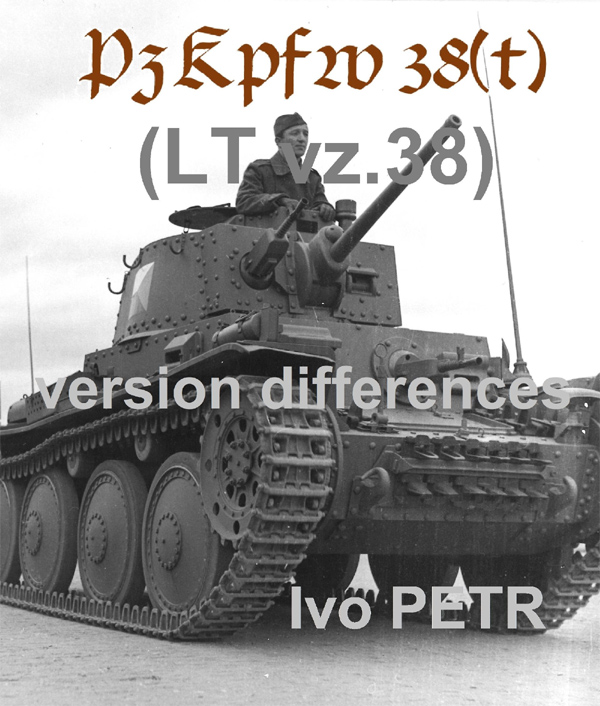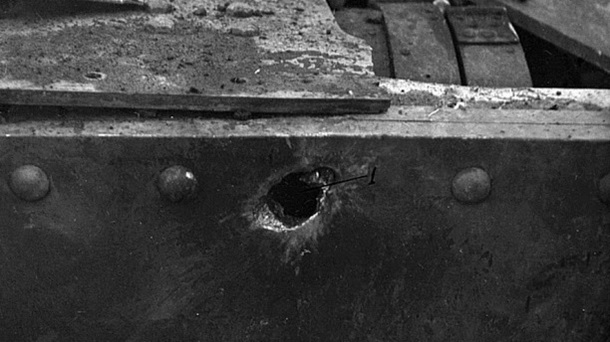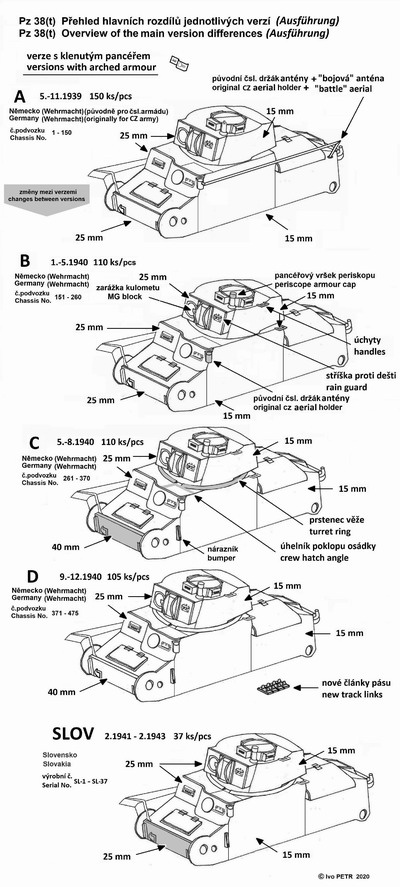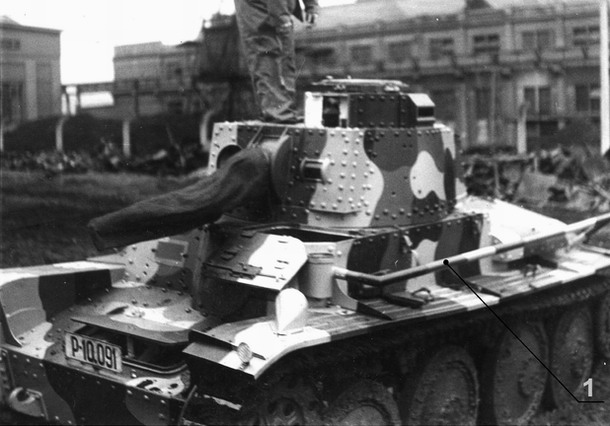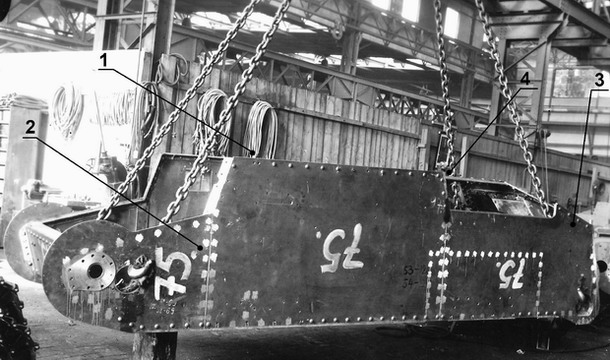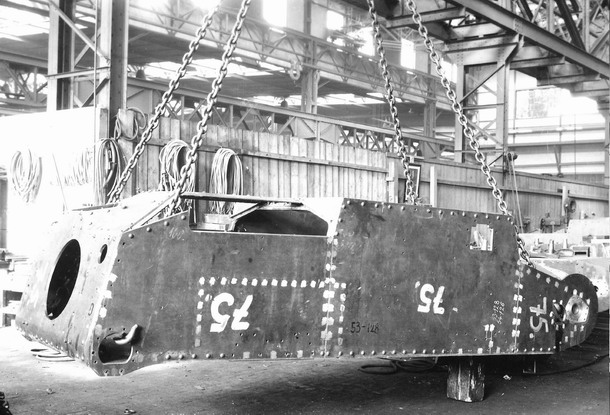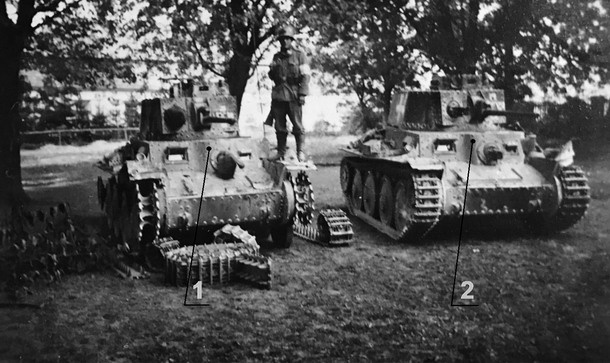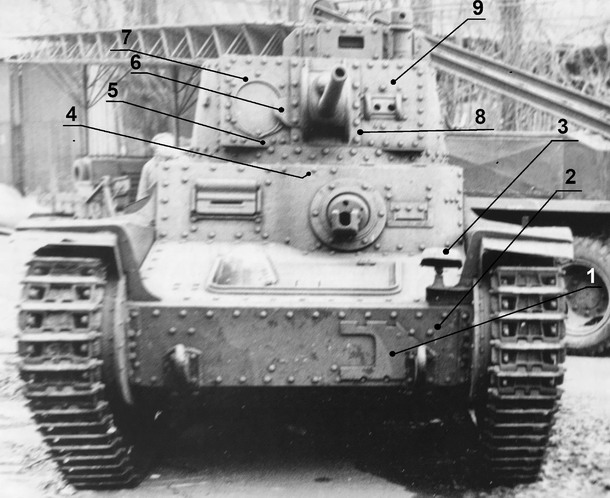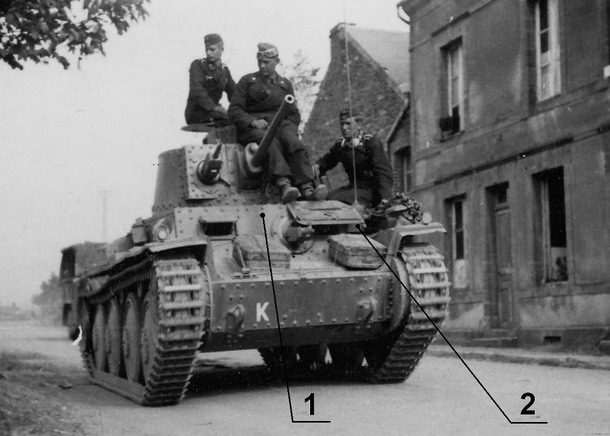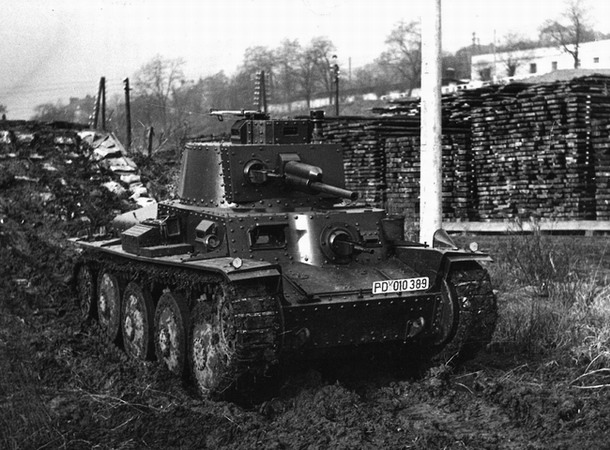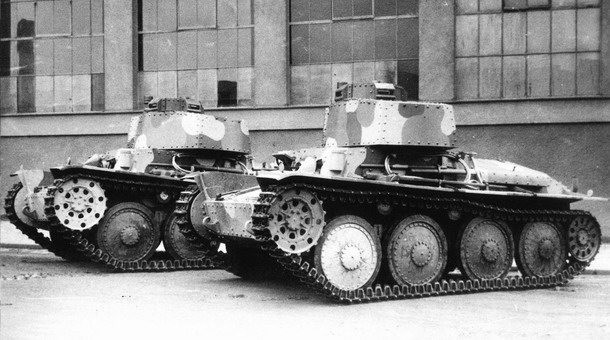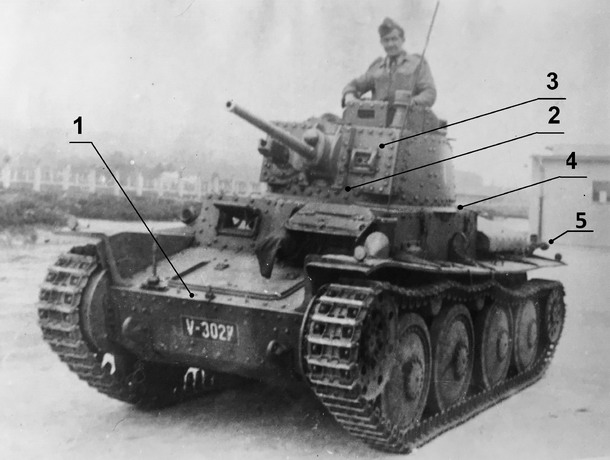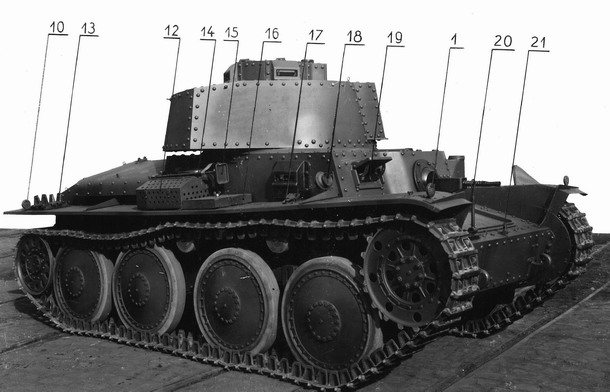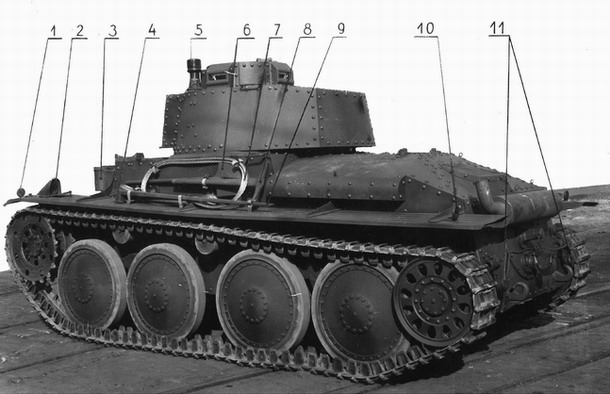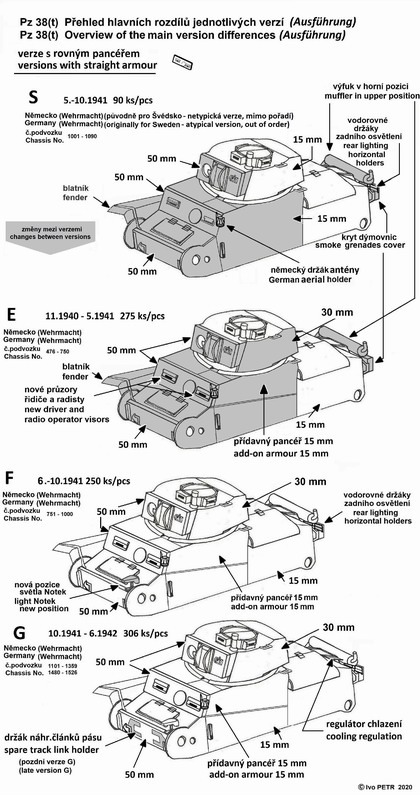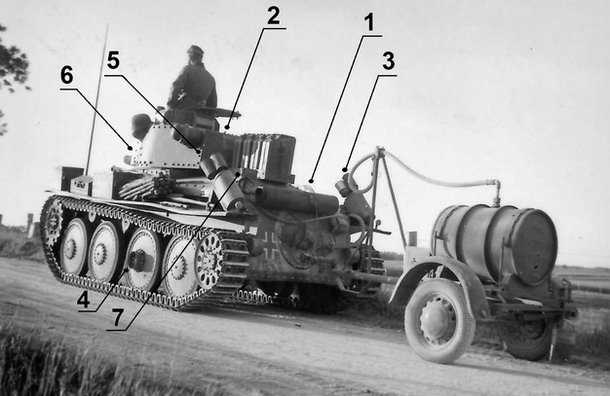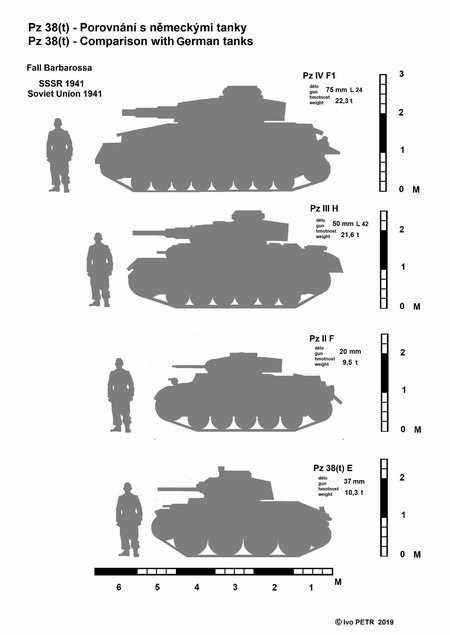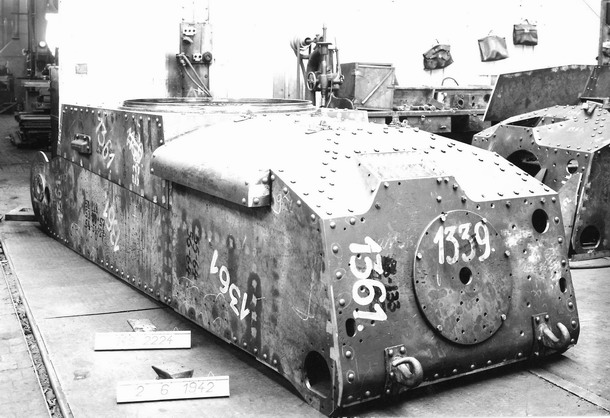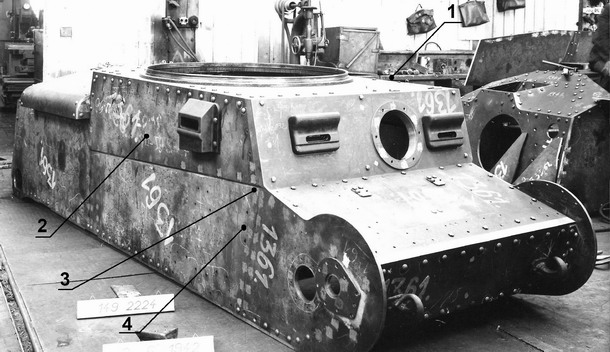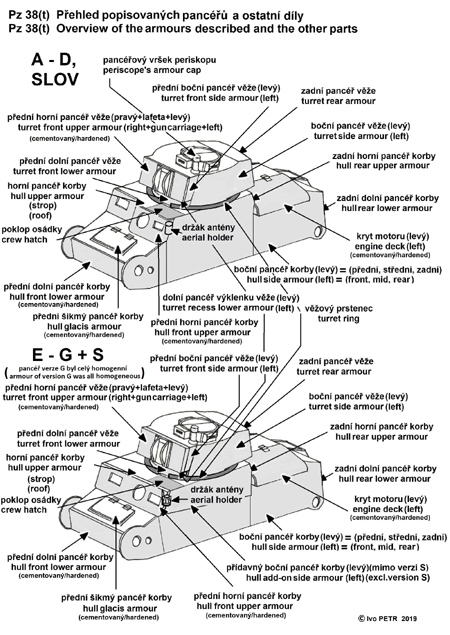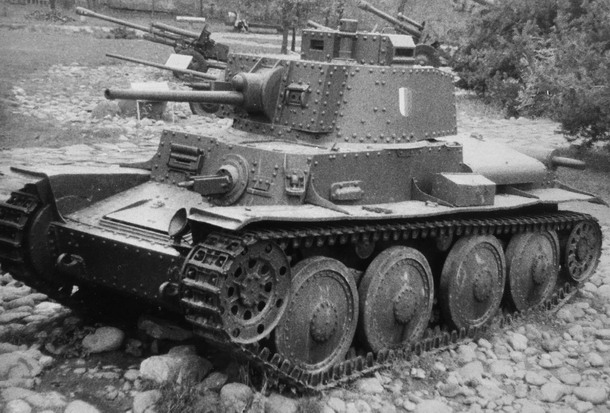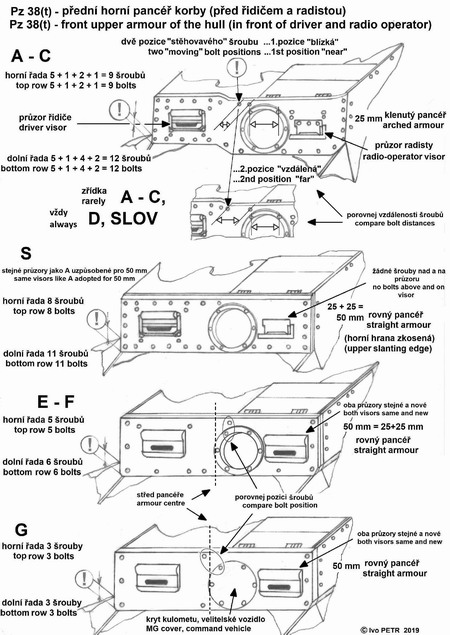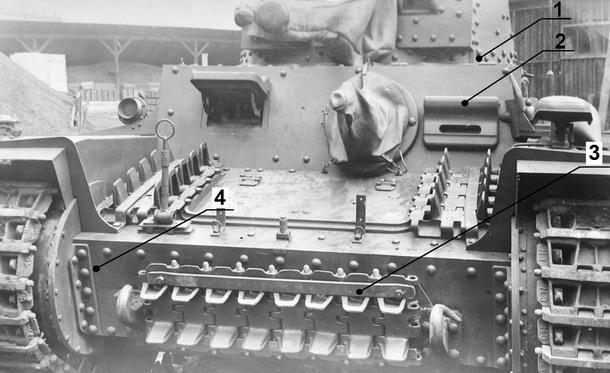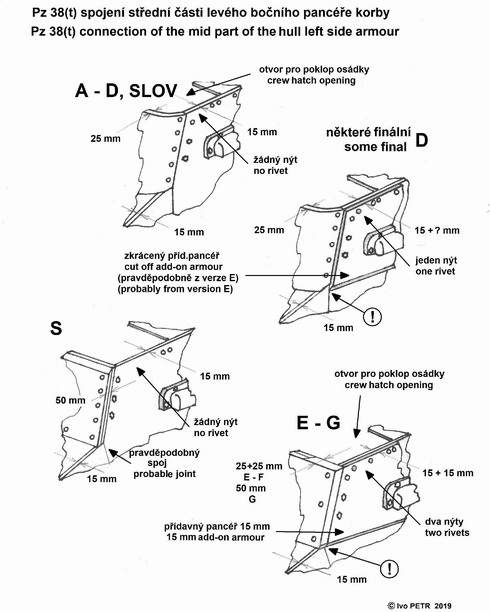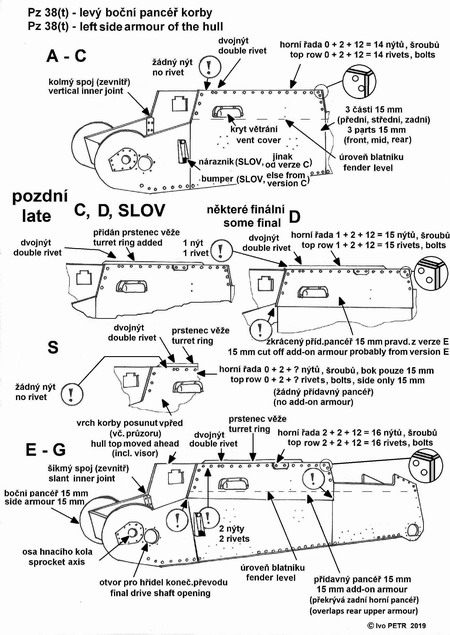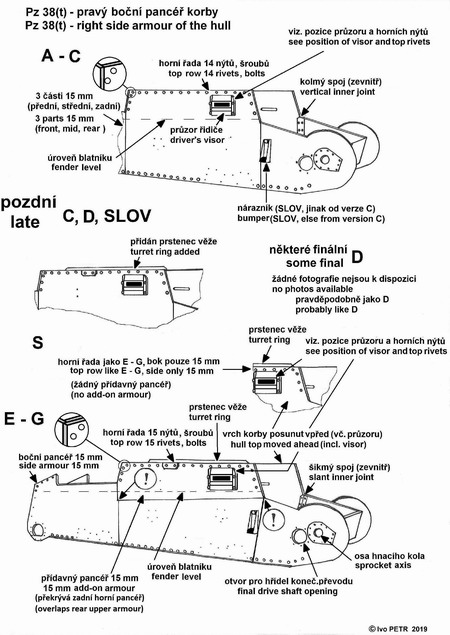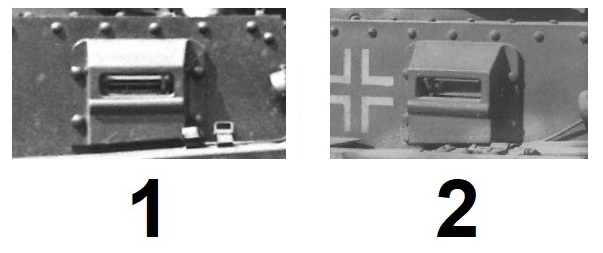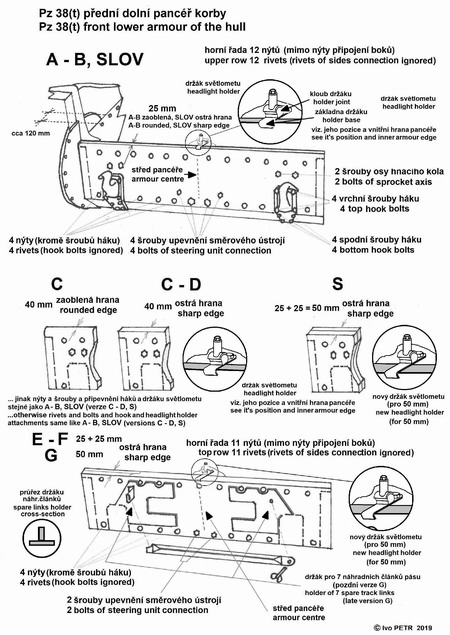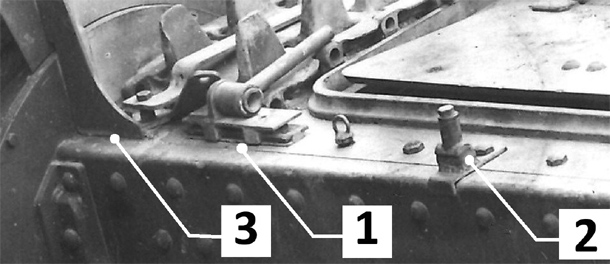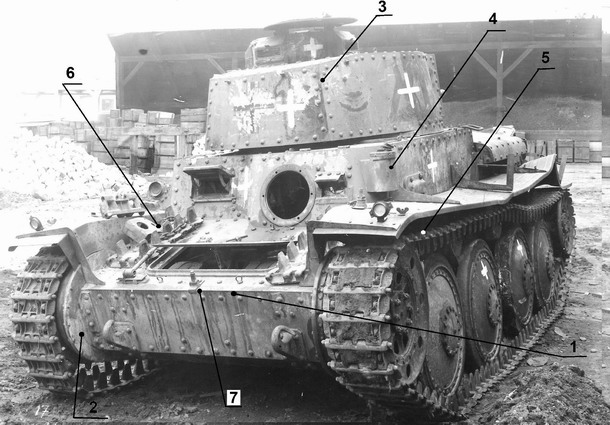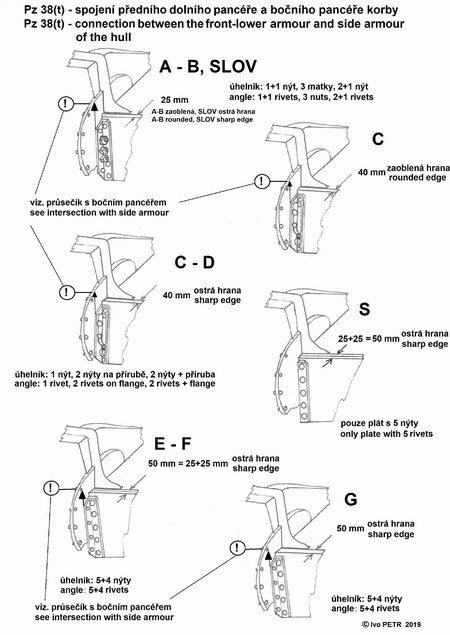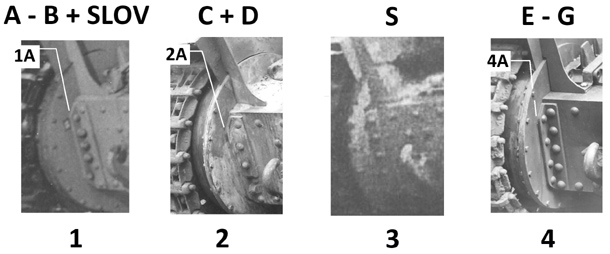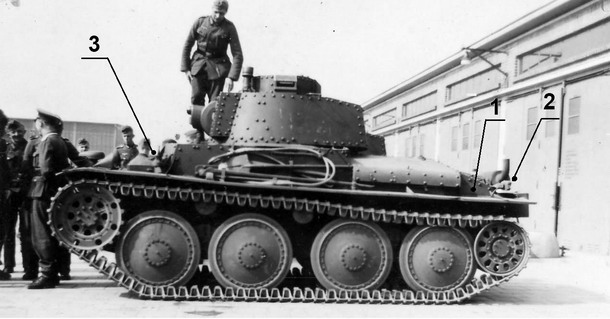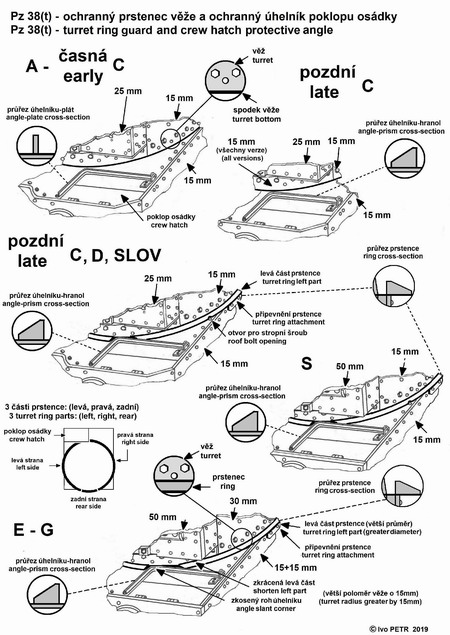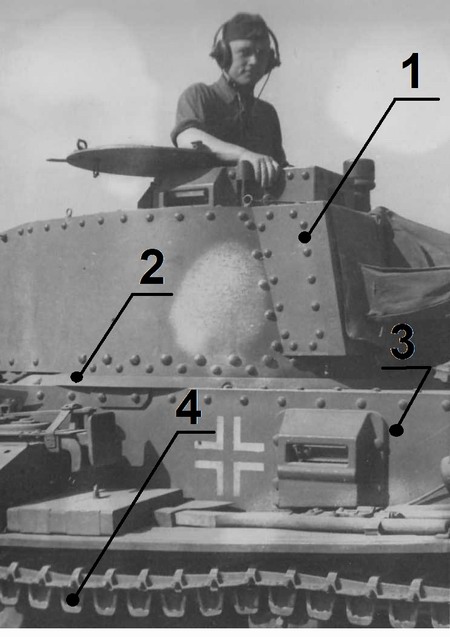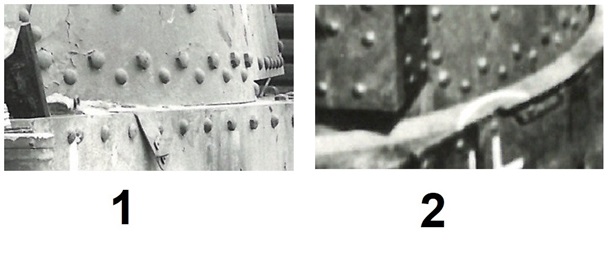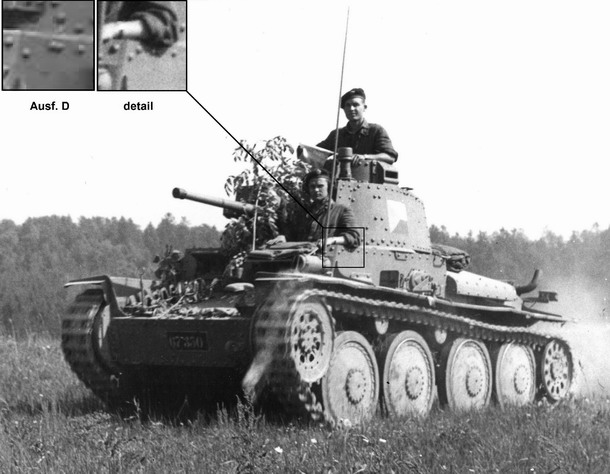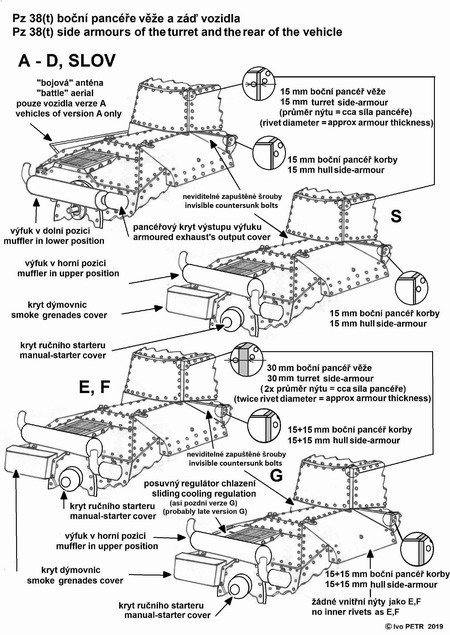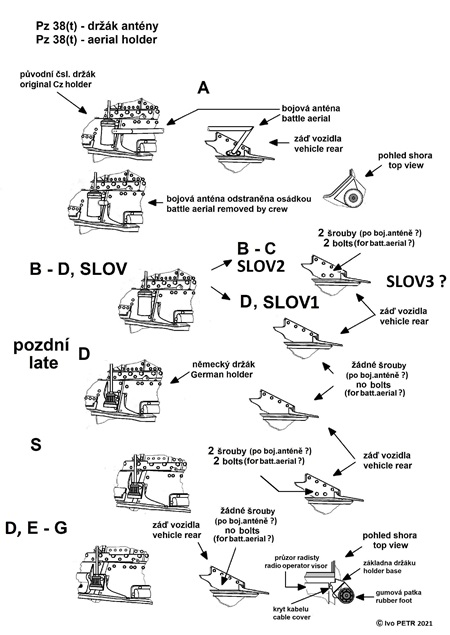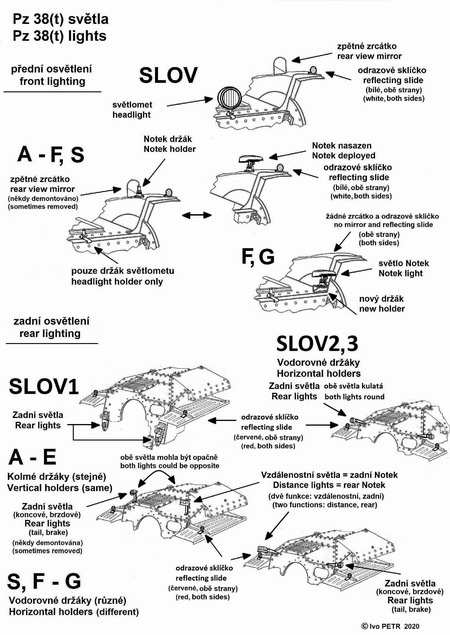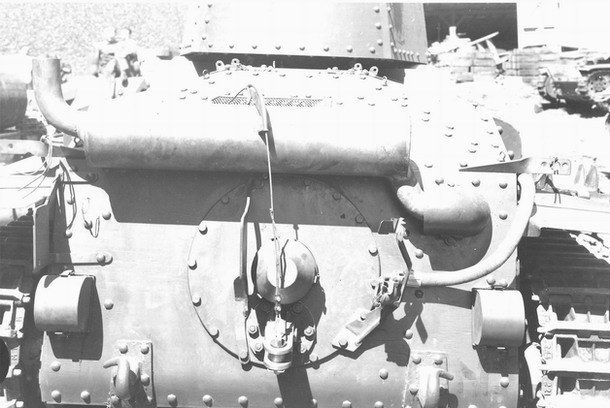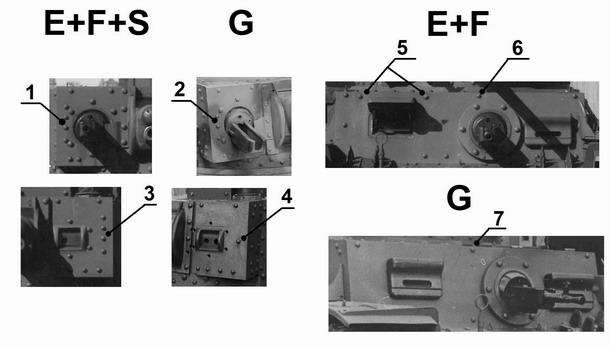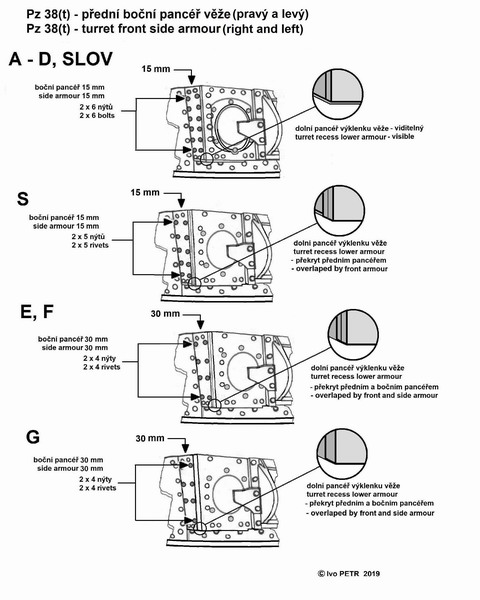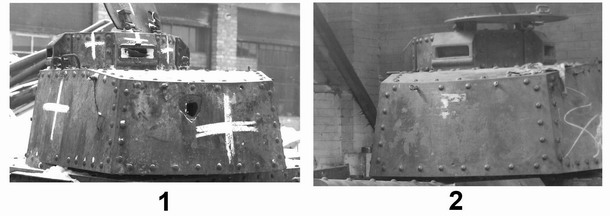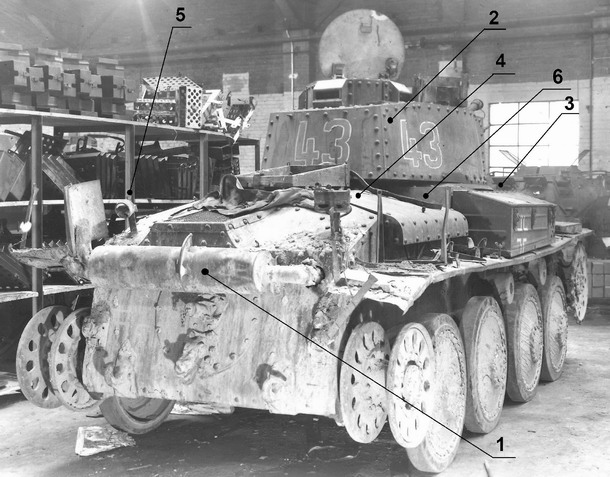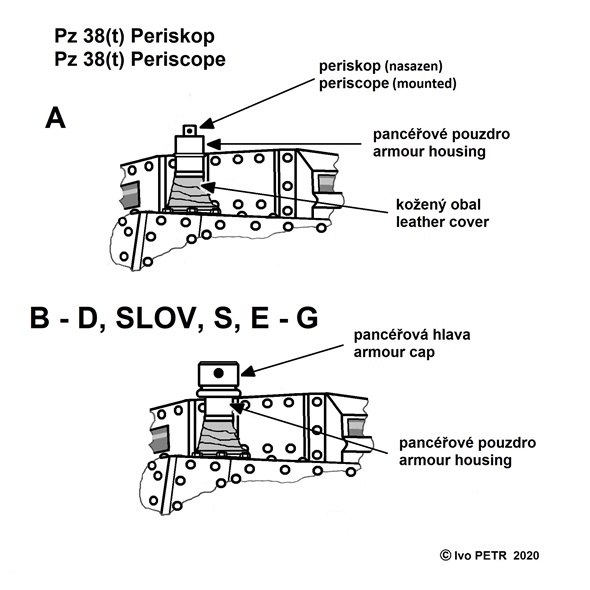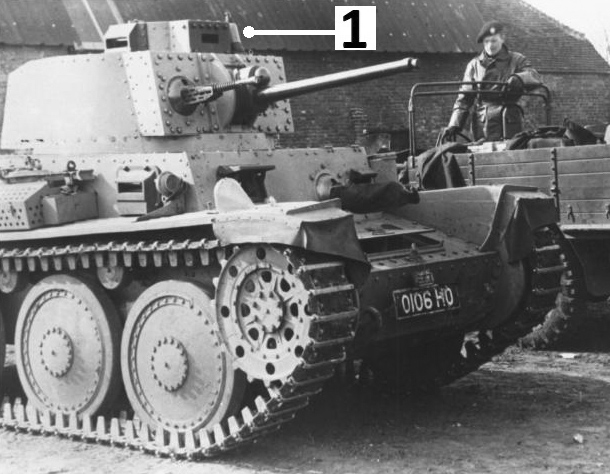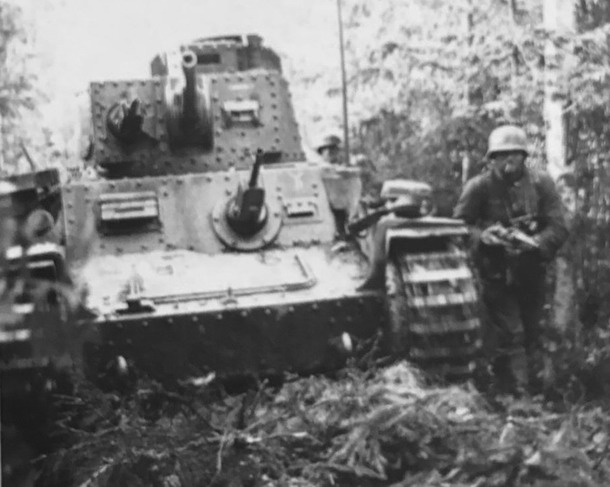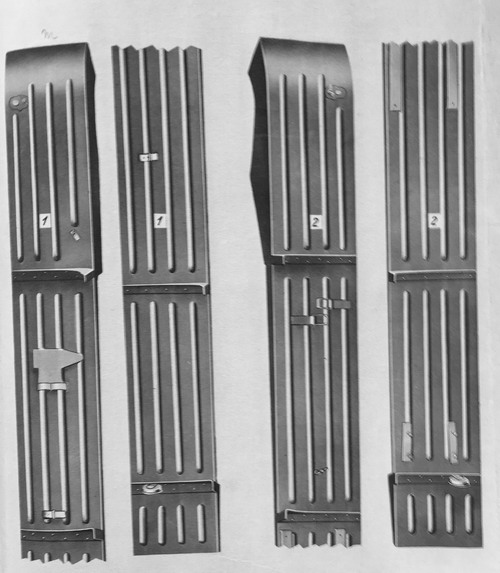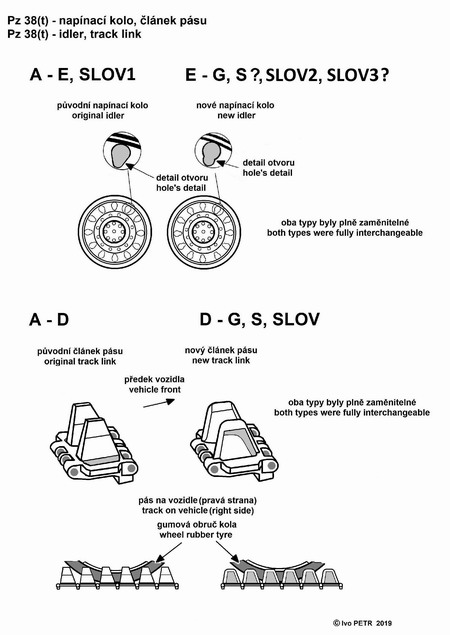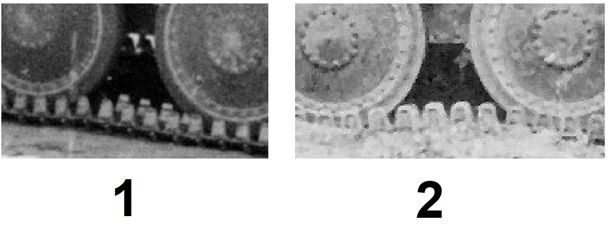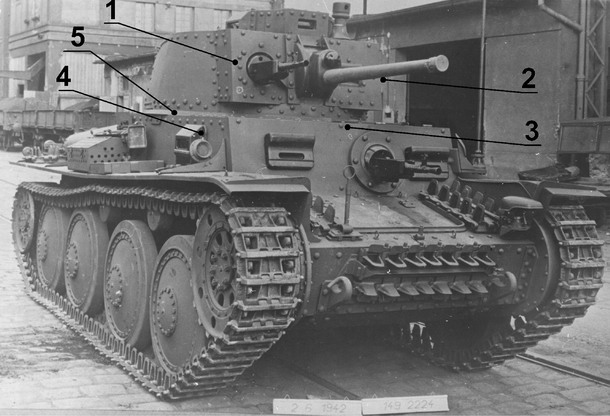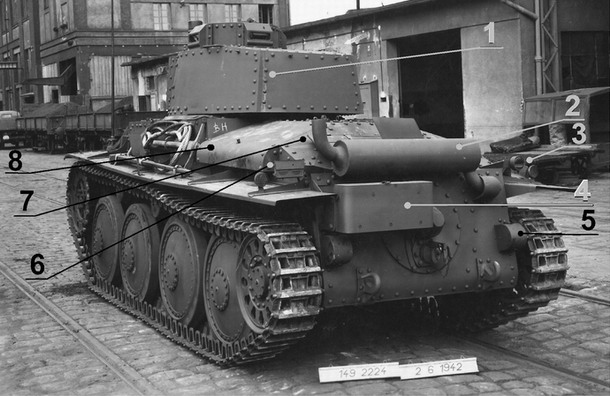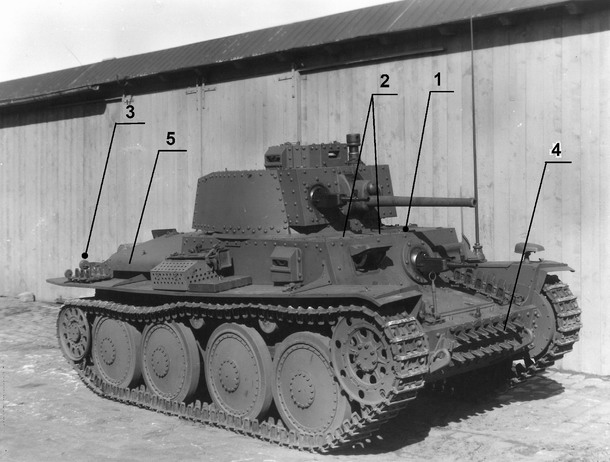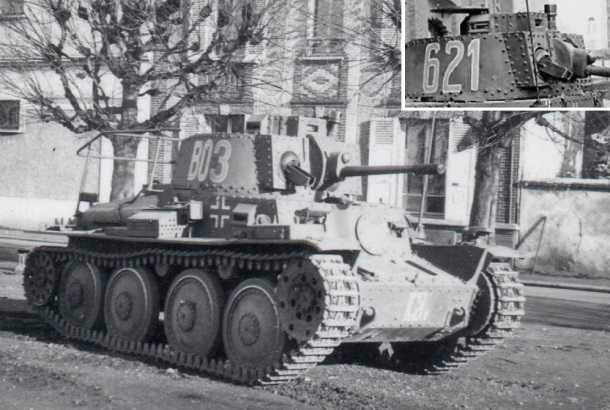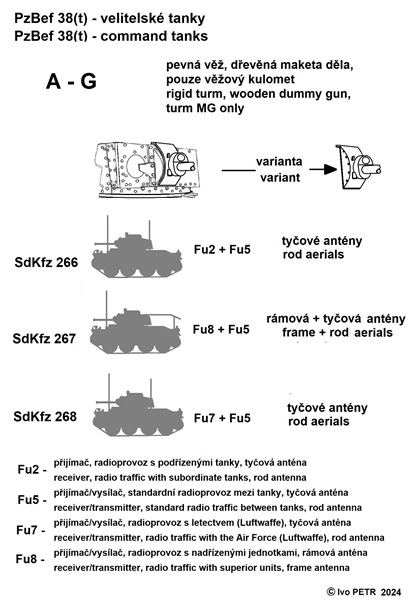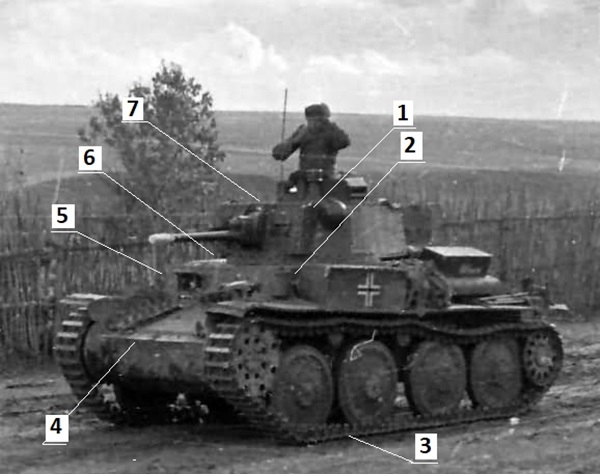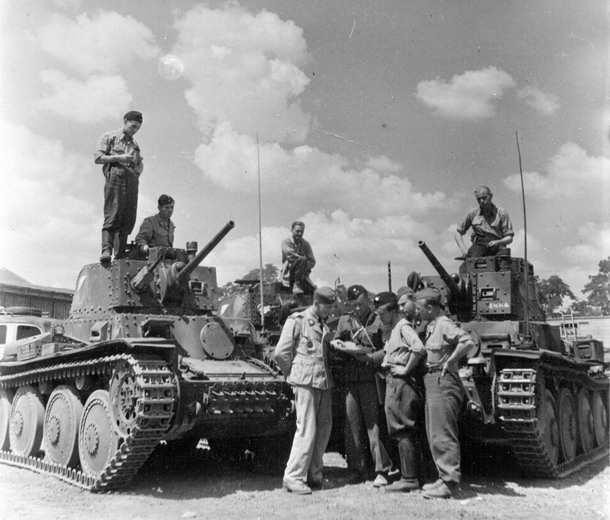|

Pz 38(t) version G. Picture from the military parade of the post-war Czechoslovak army. (Source: author's collection via J.Studený, edited) During the long years of my interest in the armored fighting vehicles of World War II, I have of course met several similar „fools“ just like myself. From all these contacts, I must highlight the one with Mr. Ivo Petr, who provided me with a lot of invaluable information and advice. For many years Ivo has been studying in detail the differences of individual versions of the LT vz. 38 light tank (or more specifically PzKpfw 38 (t) light tank). For the last two years, he has even been preparing his own publication on this topic. When I saw the prepared material, I was just amazed by the precision and level of detail of his drawings. Very quickly we came to the conclusion that we would both be honored if this work was published here, on Panzernet. For the first time ever, we are therefore bringing you an article by an "external" author. An article, which was not tailor-made for our website. For that reason the following text, in its style and structure, does not correspond to the habits of Panzernet, but respects the structure given to it by its author (which corresponds more to a printed book than a website). However I am sure you will enjoy it even though. I wish you a great reading!
The aim of the publication is to contribute to the distinction of different versions of the Pz 38(t) tank and thus to the determination of the approximate date and place of the preserved photographs. The publication deals only with the structural differences of individual versions of the Pz 38(t) tank used by the German Wehrmacht and the so-called Slovak state, but not with its additional equipment, nor does it deal with the deployment of these tanks, their marking, vehicles used by various satellite states of Germany with the exception of Slovakia, etc. Another exception is the radio equipment, that is aerial holders for radio stations, and tank lights, as these are an important distinguishing feature of various versions of Pz 38(t). The publication therefore deals mainly with the structural elements that could not be changed by field repair shops (or could, but usually were not) of the tank divisions.
Warm thanks go to the gentlemen who helped me to write this publication and whose materials I was allowed to use. These include: V.Francev, M.Uhrin, J.Tintěra, K.Trojánek, A.Kalinin, and H.L.Doyle. Special thanks go to Mr. M. Lukáš, who allowed me to publish this work on his website PanzerNet and obligingly participated in its creation. No doubt, new facts will emerge over time to clarify or possibly refute some of the claims of this publication. However, this brief overview is probably the most accurate of what the author has been able to do so far. The author will be grateful for any constructive comments on this work: Ivo PETR, Brno, Czech Republic, ivo.petr.rndr@gmail.com
NOTES ON REFERENCES IN THE TEXT References to the literature are given in square brackets (eg [1]), an overview of this literature can be found at the end of the publication in the Literature chapter. The original German terms are in bold italics and in brackets, eg: (Ausführung). The abbreviation "pd" is for the German term "Panzer Division", which means "armoured division".
Sources to describe the differences between the individual versions of the Pz 38(t) tank are relatively scarce. One should keep in mind that during the war these subtle differences other than the number of pieces produced, or the caliber of the tank gun or the strength of the armour were not significant. The sources of information for this publication included mainly factory photographs of the tank, photographs of damaged vehicles on the Russian front sent to the ČKD factory for repair, dozens of photographs of the Pz 38(t) tank and especially the German BOM (Vorlaufiges K-Gerätverzeichnis PzKpfw 38 (t), Ausf.A-H und S, Berlin, 1942) [1], which the Germans, with their typical consistency, issued for the needs of the units that used this tank. Unfortunately, there are very few written archival materials available. Many of them burned down during the American air raid in March 1945, which shows, among other things, that it is not good to have an archive in places that it deals with.
NOTES ON THE REPAIR WORKSHOPS OF TANK DIVISIONS Repair shops (Werkstatt Kompanie) were an organic part of every German (and not only German) tank division. During World War II, tanks fought mostly during the day and gathered at a designated location after the end of the fighting. Here the tank crews rested, while the repair shops carried out (often overnight) routine tank repairs for the next day. The equipment of these workshops also included welding equipment, as it is common to see tank armour "patched" at the places of the shot with a spare piece of armour. It was the custom of these divisions, after the delivery of tanks from the weapons depot, to equip the tanks with various additional equipment (boxes, non-standard smoke throwers, various holders, etc.), which was often characteristic of individual divisions. Therefore, if the photograph of the tank lacks the emblem of the division, it is possible to identify it by this equipment. It is interesting that the company ČKD (BMM) produced Pz 38(t) tanks with the same additional equipment, which was probably insufficient in field conditions.
MANUFACTURERS OF ARMOUR FOR Pz 38(t) AND "SPLIT" ARMOURS The armour was supplied by two companies: „Poldi Kladno“ (city of Kladno) and „Vítkovické horní a hutní těžířstvo“ (city of Ostrava). According to archival materials, both of these suppliers had problems, at least at the beginning, with the timely delivery of armour plates. During the production of the tank, its armour was gradually strengthened. Version E was produced with a front armours thickness of 50 mm (previous versions A-D had these armours of only 25 mm). These were the front hull armours (upper and lower) (for a detailed description, see the chapter Hull front upper armour and the Hull front lower armour) and the front turret armour (for a detailed description, see the chapter Turret front upper armour). However, these armours were initially formed by a pair of 25 + 25 mm armour. For version E, this is also described in the message of the S.T.T. (School of Tank Technology, England), which was one loot tank sent from Russia (there are photos of this vehicle with the number 545 on the turret - the English also recorded the chassis number (FgstNr) 666, i.e., version E) and was tested here in August 1942 [ A2]. Care must be taken not to confuse it with the testing of the LT 38 prototype, which took place in England in the spring of 1939 in M.E.E. (Mechanization Experimental Establishment). The F version also had these armours divided. It is, therefore, probable that the S version had the armour divided in this way as well. This version was produced in parallel with the E version, but this version cannot be precisely determined from the surviving photographs. In any case, the connection of the armour divided in this way in ordinary photographs was practically indistinguishable due to their grinding and overcoating. This was only possible if the tank had been hit at this point by an enemy missile. It is not known why such divided armour was used. A possible explanation may be that the technological equipment used could only manufacture armour up to a certain strength.
In the summer of 1941, the Red Army subjected the captured Pz 38(t) version E from the 20th Panzer Division to shooting tests. The photo clearly shows the division of the front lower hull armour after a shot from a 45 mm gun at a distance of 500 meters. (Source: Flickr.com, modified) The most endangered tank armours (and this includes especially the front armours) were surface hardened by so-called cementation. Cementation is a time-consuming process in which the surface layer of a homogeneous armour is cured by various chemical processes. Because the original 25 mm front armours of the Pz 38(t) tank were cemented, it can be assumed for the divided armours that the upper armour was cemented, the inner was homogeneous. Needless to say that, as the production of cemented armour was lengthy (and therefore expensive), homogeneous armour was generally preferred in the WWII construction of tanks. One more small note on the production of armour. If the homogeneous armour had been rolled, i.e. "compacted", it became much more durable. On the other hand, cast armours made it possible to give the armour the desired shape, which was used, for example, in the construction of round tank turrets. The German design school preferred rolled armour, even on tank turrets.
The construction of the tank was conservative, i.e., the parts of the hull and turret were connected by bolts and rivets on a skeleton of angles and profiles, which was both laborious and expensive. Even at a time when large manufacturers of tank equipment (Germany, Russia) switched over to welding technology, which was faster and especially the final product (tank) was much more resistant to damage in combat. Joining with rivets was done "on color" (according to the memories of a participant in the production of TNH tanks for Iran in 1937). The joined parts were painted at the joints, then joined with bolts and disconnected again, and where the paint did not extrude, the material had to be ground. This procedure was repeated 2 to 3 times until the joint was ideally straight. Only then were the parts riveted. So it definitely required hard work. For easier access to the internal units of the tank or possible replacement of damaged parts, part of the tank's armour plates were fastened with bolts - they were therefore removable. For some joints, countersunk bolts were also used, which were usually reground and painted over from the outside, so that the joints were practically invisible. On the surface of the tank structure, however, the fastenings described above, whether by means of bolts or rivets, appear the same. In later versions (especially from version E) it was used to fasten some parts with bolts from the inside of the tank structure, so it was not visible from the outside. It is interesting that the construction technology of the Pz 38(t) tank remained unchanged throughout its production and the Pz 38(t) tank was also the only foreign tank that was included by the German Wehrmacht in large numbers in its units (Panzer Division) (of course if we do not take Pz 35 (t) tanks). It was only in 1944 that ČKD (BMM) completely went over to the technology of welding strong armour plates, when it started the production of tank fighter Jagdpanzer 38 (t) "Hetzer", based, of course, on the proven chassis of the light tank Pz 38(t). The distinction of the individual versions thus require the (tedious) counting of the bolt heads and rivets on each part of the tank structure.
OVERVIEW OF THE PRODUCTION OF INDIVIDUAL VERSIONS Light tank Pz 38(t) (exactly PzKpfw 38(t) = Panzerkampfwagen 38(t), „t“=“tschechisch“, for simplicity, we will keep the final German designation of this tank, in the original Czechoslovak army it was referred to as LT vz.38) was manufactured in 1939-1942 by the Prague ČKD (Českomoravská Kolben Daněk), which the Germans renamed in the Protectorate to BMM (Böhmisch-Mährische Maschinenfabrik AG), because Mr. Kolben was of Jewish descent. Gradually, the German Wehrmacht was delivered 1396 pieces in versions (Ausführung) A - G and S. In the last purely tank version G only 306 tanks were produced, the other chassis (194 pieces) were used for the tank fighter Marder III. The S version (90 vehicles) was a version originally produced for Sweden (Schweden), but was confiscated by Germany in 1940 being modified for almost a year to suit the needs of the Wehrmacht. Finished vehicles for the Wehrmacht were delivered as standard to the main tank warehouse in Magdeburg (Heereszeughaus Magdeburg) and, from 1941, to the warehouse in Vienna (Heeres Panzer Werkstatt Wien), from where they were taken over by the relevant units. An exception was, among other things, the takeover of the first original Czechoslovak LT-38 tanks in May 1939 (i.e., Ausf. A), which the German tank crews drove directly to their home barracks. The Germans added another crew member (the number increased from the original 3 to 4 members), namely the charger / gunner from the machine gun in the turret. Originally, the crew counted 3 members: commander/gunner of the gun in the turret, driver and radio operator/shooter of the machine gun in the hull. In addition to these vehicles, ČKD (BMM) also produced 37 pieces for the Slovak state, in three series of 10, 20 and 7. These vehicles will be referred to in this publication as Pz 38(t) SLOV, or as Pz 38(t) SLOV1 - SLOV3 to distinguish individual deliveries, although the factory designation of the manufacturer of these vehicles was TNH Sl and by the Slovak state referred to as LT 38 (Light tank 38). The individual versions of the Pz 38(t) tank are given by the scope of production orders rather than by changes in the tank design, but characteristic differences can be traced in the individual versions. However, it should be noted that these changes were introduced into production continually, often during the production of a particular version, and the name of the version thus served the units mostly only for specifying the needed spare part in an order to the manufacturer.
data taken from the book: Francev V., LT vz.38 Tank, which succeeded, Svět křídel, Cheb, 2019
Overview of main version differences, versions with arched armour, CLICK FOR FULL SIZE One of the first produced LT 38 (Pz 38(t) Ausf.A) in May 1939 still in pre-war Czechoslovak camouflage on the premises of ČKD. Optical instruments have not yet been mounted. Note the Czechoslovak aerial holder and the so-called "combat" aerial (1), especially its mounting. (Source: ČKD archive via V.Francev, modified), CLICK FOR FULL SIZE Version A basically corresponded to the construction of the tank, which was ordered by the original Czechoslovak Army as LT vz.38. The thickness of the armour on the front armours of the hull and turret was 25 mm, the side armour of the turret and hull was 15 mm thick, the structure of the front upper armour of the hull (in front of the driver and radio operator) had a convex forward protrusion (so-called "arched" armour). The armour met the requirements of the Czechoslovak military administration to make the tank resistant to infantry weapons. Tanks LT vz.38 (i.e., Pz 38(t) Ausführung A) were produced from May to November 1939 in 150 pieces with the first pieces produced being taken over by the German Wehrmacht in May 1939. Tanks version A were then used in combat in the Polish campaign in September 1939. In the photos from this campaign, it is possible to see these tanks with large white crosses instead of the sovereign designation-black crosses and sometimes with the original Czechoslovak headlight. These white crosses were used on all German tanks only in this campaign. This version was characterized by, among other things, a tubular, so-called "combat" aerial above the left fender of the tank (for a detailed description, see the Aerial chapter). However, some crews dismantled it. The commander's periscope (for a detailed description, see the Periscope chapter) is still without the armoured cup (see version B). The confidence of the German authorities in Czechoslovak tank was considerable so that, before the Polish campaign began, in June 1939 the Germans ordered another 325 pieces (these were then implemented as versions B - D). In the same year in October, after the end of the Polish campaign, an order for another 275 pieces followed (these were then realized as version E) and, in the following year 1940, another order for another 250 pieces (these were realized as version F). The reason for this "success" of the Pz 38(t) tank, however, should be seen mainly in the fact that the German Pz III type tanks, intended mainly as the backbone armament of the German tank divisions, were few. In addition, the fact that the Pz 38(t) was twice as cheaper and was much smaller when armed with the same 37 mm gun (only for the attack on the USSR in 1941, the Pz III tanks were armed with a 50 mm gun with short barrel L42(length in calibers, L = length)) certainly played a role. Pz 38(t) version A. General view of the hull of the vehicle No.75 from the left. The photos were taken during the production of the first series of the Pz 38(t). Note: the holes for the "double" rivet of the plug of the crew cover (1), the ground connection of the front and middle part of the side armour, which is perpendicular (2), the two holes for mounting the "combat" aerial (3) and the visibility of the edge of the rear upper armour (4). (Source: ČKD archive via V.Francev, modified), CLICK FOR FULL SIZE Pz 38(t) version A. General view of the hull of vehicle No.75, this time from the right. (Source: ČKD archive via V.Francev, modified), CLICK FOR FULL SIZE Photograph of two tanks Pz 38(t) version A from Poland in 1939. The photo is interesting in that there are two tanks with each having a different arrangement of the so-called "moving" bolt on the armour of the hull in front of the radio operator near the bend of its niche. The vehicle in the picture on the left has it in the "near" position (1), the vehicle on the right in the "far" position (2). (Source: K.Trojánek Photo Archive, edited), CLICK FOR FULL SIZE Photo of the exhibit of the VHÚ tank Pz 38(t) production No. 008 (i.e., version A) in the former state in a museum in Kbely. Now the vehicle is modified as an exhibit of the Lešany Museum. It is worth noting the front armours of the hull (upper and lower) and the front armour of the turret, especially the arrangement of the fastening bolts and rivets on these armours, which was the same for A-D and SLOV versions, except for the so-called "moving" bolt, which is here in the so-called "near" position (4). Note the turret MG ring (7), its stop on the left side (6) and the cover of the gun sights(9). The vertical bars of the gun carriage (8) do not extend above the small semicircular lower armour of the turret, above which the characteristic "tooth" (5) of the front armour of the turret, typical of versions with 25 mm armour, can be seen. Here this "tooth" was formed by the bottom plate of the front protrusion of the turret and its edge was visible. The vehicle has a Notek light (3) located on the front lower armour and the left part of a standard spare track link holder (1) which is adapted not to interfere with the bolts (2) securing the sprocket axle above the left hook. Both are undoubtedly modifications of a later nature. (Source: V.Francev Collection, edited), CLICK FOR FULL SIZE Probably Pz 38(t) version A. Note that the periscope does not have an armoured cup, at the top on the edge of the turret roof there is no holder for the crew and the aerial holder is of the Czechoslovak type, only with a "protrusion" for mounting a "combat" aerial. The tank has the original track links. The double "strip" of bolts and rivets located at the bottom front and sides of the turret is clearly visible. This "strip" will serve well in determining the existence of a turret ring guard. (Source: World War Photos, edited), CLICK FOR FULL SIZE Tanks Pz 38(t) Ausführung B (version B) were produced from January to May 1940 in 110 pieces with changes brought about by the combat deployment by the Germans. The so-called "combat" aerial disappeared, as did the protrusion on the aerial holder, on which it was mounted. The periscope, which had so far protruded slightly above its protective housing, received cover in the form of an armoured cup (for a detailed description, see the Periscope chapter). Furthermore, a handle was attached to the crew on the left side of the turret. (for a detailed description, see chapter Handles). A rain guard was also added to the sight apertures of the gun, and the turret machine gun received a stop limiting its movement towards the main gun (for a detailed description, see the Turret chapter).
Tanks Pz 38(t) Ausführung C (version C) were produced from May to August 1940 in 110 pieces. In this version, the Germans, probably based on the first combat experience of this tank in the Polish campaign, reinforced the front lower armour of the hull (in front of the steering system) to 40 mm, which was the simplest solution, as no weapons were mounted here. This solution can be considered provisional. During the production of this version, the original plate protection angle of the crew cover was replaced by a stronger, prismatic angle (for a detailed description see chapter Crew hatch protection angle), probably before the turret ring guard introducing in this version (for detailed description see chapter Turret ring guard). At the same time, during the production of this version, a shock absorber (bumper) was installed on the side armour of the hull just above the first running wheel to prevent the tank hull from hitting a possible obstacle or to prevent the tank from vibrating while driving (for a detailed description see chapter Hull side armours). Pz 38(t) version A according to the source of the photograph from France in 1940. The large white letter "K" on the front lower armour of the hull indicates membership in the tank group of general von Kleist. Worth noting are the front armours of the hull (upper and lower) and the front armour of the turret, especially the arrangement of fastening bolts and rivets on these armours, which was the same for A-D and SLOV versions, except for the so-called "moving" bolt, which is here in the so-called "far" position (1). The Czechoslovak type aerial holder still has a "protrusion" for mounting the "combat" aerial (2). (Source: World War Photos, edited), CLICK FOR FULL SIZE Tanks Pz 38(t) Ausführung D (version D) were produced from September to December 1940 in 105 pieces. This was the last version (if we do not take into account the version of SLOV for the Slovak state) with an "arched" front upper hull armour (in front of the driver and radio operator) 25 mm thick, followed by versions with this armour straight and 50 mm thick (for a detailed description see Chapter Hull front upper armour). During the production of this version, the original Czechoslovak aerial holder was replaced by a German one, which was placed on a rubber foot and allowed the aerial to be tilted in contact with a rotating gun (for a detailed description, see the Aerial chapter). At the same time, new, lighter track links were introduced (for a detailed description, see the Tracks chapter).
VERSION SLOV (version for Slovak state) The Slovaks have always been specific and this was reflected in their tanks. A total of 37 Pz 38(t) tanks were delivered to Slovakia in three series of Pz 38(t) SLOV1 (10 pieces), Pz 38(t) SLOV2 (20 pieces) and Pz 38(t) SLOV3 (7 pieces). The Slovaks bought tanks separately from ČKD (BMM), guns separately from the Škoda company to make it cheaper. Pz 38(t) SLOV tanks were with an "arched" front upper hull armour (in front of the driver and radio operator), but their front lower hull armour was only 25 mm thick, unlike the "German" versions C - D, which already had this armour 40 mm thick (for a detailed description, see the chapter Hull front lower armour). Otherwise, they corresponded to the Pz 38(t) D version, including the turret ring guard (for a detailed description, see the chapter Turret ring guard). Because production for the German Wehrmacht was, of course, always a priority, their deliveries took some time. Production of the first series began sometime early in 1940, and the first two vehicles were completed on September 26 of that year. The rest of the series was released by the end of November this year. Not so the guns, their final assembly and shooting taking place in February 1941. With the second series of Pz 38(t) SLOV2 it was much the same (tanks delivered in January 1942 and guns mounted in June 1942) and the series Pz 38(t) SLOV3 (tanks delivered in October 1942, the guns had only been installed in them by February 1943). Then the Slovak state received another 37 pieces of Pz 38(t) (20 pieces in October 1943, 12 pieces in February 1944 and the last 5 pieces in July of the same year) directly from the German tank warehouse in Vienna (Heeres Panzer Werkstatt Wien) and it was Pz 38(t) tanks of all "classic" versions, including version S. Other deliveries were of course interrupted by the outbreak of the Slovak National Uprising. Pz 38(t) version SLOV1. Photo from vehicle tests in ČKD. The vehicle has temporarily the front plate of the turret with a 37 mm A4 gun installed (probably a model, the same gun was on the LT 35). Note: 25 mm front lower hull armour with sharp edge and its connection to the sides, 25 mm front upper hull armour and visors on it, the position of the front edge of the driver's side visor in relation to the upper row of side armour rivets and turret ring guard and its recesses for bolts of the roof mounting. (Source: ČKD archive via V.Francev, modified), CLICK FOR FULL SIZE Pz 38(t) version SLOV1. Photo of the first two manufactured vehicles, still in Prague in ČKD. According to archival sources, it was in September 1940. The tanks have turned turrets because the guns are not yet installed. The original Czechoslovak three-color camouflage is interesting. Note the 15 mm side armour of the turret, the new type of track links and the lower position of the muffler. (Source: ČKD archive via V.Francev, modified), CLICK FOR FULL SIZE Pz 38(t) version SLOV2 V-3027 from the second delivery to the Slovak state. For deliveries of SLOV2 and SLOV3, guns were already available only for 50 mm turret armour. Because Pz 38(t) SLOV2 and SLOV3 had this armour only 25 mm thick, special pads were used under the vertical bars of the gun carriage and thus these bars (2) protruded above the front lower armour of the turret. A modified cover of the gun sights (3) of versions Pz 38(t) E-G + S was also used. The SLOV2 and SLOV3 versions had horizontally mounted rearlights(5), round on both sides of the hull and different from the German round Bosch rearlights, which were only on the right. The rear Notek distance lights were completely missing here. Otherwise, the SLOV2 and SLOV3 versions were the same as SLOV1. Worth noting is also the sharp edge of the 25 mm front lower hull armour (1) and the existence of a turret ring guard(4). (Source: Photo archive of the SNP Museum, sign.7076, modified), CLICK FOR FULL SIZE Pz 38(t) version of SLOV1. Photo from the crew manual. 1) front reflecting slide, 10) rear reflecting slide, 12) accessory box, 14) tool mounting, 13) spare track links, 15) jack, 16) pad under the jack, 17) tool holder, 18) horn, 19) driver's visor, 20) hull MG sight, 21) headlight holder. (Source: ČKD archive via V.Francev, modified), CLICK FOR FULL SIZE Pz 38(t) version of SLOV1. Photo from the crew manual. 1) front reflecting slide, 2) rear-view mirror, 3) Czechoslovak aerial holder, 4) hammer, 5) periscope, 6) shovel, 7) steel rope, 8) pickaxe, 9) crowbar, 10) rear reflecting slide, 11) rear lights. Except for the rear lights, both photographs can be used to describe parts of Pz 38(t) versions A - D. Handles for crew boarding are also clearly visible in this photo. One is situated in the middle on the edge of the roof and the side of the turret, the other at the end of the edge of the roof and the side of the combat space of the hull. The handle on the turret started to be mounted from version B. (Source: ČKD archive via V.Francev, modified), CLICK FOR FULL SIZE Overview of the main version differences, versions with straight armour, CLICK FOR FULL SIZE The S version was somewhat unusual, as it strongly "deviated" from the usual Pz 38(t) series produced for the German Wehrmacht. The entire delivery of 90 tanks was originally intended for Sweden, but these tanks, finished by about mid-1940, had been confiscated by Germany (each tank was good, after all, Germany was at war) and it took almost a year for the tanks to be redone to the German standard. The tanks were, therefore, adapted to be as similar as possible to the then produced version E. However, version S differed from version E (and all subsequent versions F and G) also in that it had only 15 mm side armour of the turret (compared to 30 mm) and lacked the additional armour sides of the hull with a thickness of 15 mm. The driver's and radio operator's visors remained practically the same as in the A-D versions, they were only adapted for 50 mm armour. This version was then somewhat different and photos of tanks of this version are relatively rare. Thanks to the above-mentioned modifications, its deliveries were thus delayed, realized mostly as supplements for losses sustained by the units on the Russian front only in 1941 (May to October 1941). Pz 38(t) version S. The photo comes from a series of photographs of vehicles sent from Russia to the parent factory for repair or disposal. Approximate date: autumn/winter 1941/42. This means that this vehicle has been used by the unit for some time. Note that there are no bolts above and on the radio operator visor(1), as is the case with versions A-D and SLOV. On the contrary, a Wehrmacht division 20. pd sign can be seen above this visor. Also note the upper bevelled edge of the front upper hull armour (2), the bolts on it, and the turret ring guard(3) with the atypical top cover. (Source: ČKD archive via V.Francev, modified), CLICK FOR FULL SIZE The design of the tank underwent a major change from version E at the end of 1940. The tank received armour on the front hull armours (two) and turret front armour(one) 50 mm, the side armour of the turret was strengthened to 30 mm, the construction of the front upper hull armour (in front of the driver and radio operator) was straight and the whole moved forward to the original level of the arched armour, which slightly increased the combat space in the tank. As a result, the upper hull armour (roof, extended), the side hull armours (extended) and the front sloping hull armour (shortened) were also changed. An additional 15 mm armour was added on the sides of the hull (partly, approximately above the upper level of the tracks and only in the middle part) (the side armour thus reached here a thickness of 30 mm). However, the 50 mm thick armour was divided, i.e., 25 + 25 mm. New (cast) driver and radio visors were used. By increasing the strength of the front armour to 50 mm, the tank became "heavier" in the front. This was offset by the addition of one blade to the existing 14 suspension blades of the front wheels. However, the number of suspension blades can only be seen in very detailed photographs, so it doesn't make much sense to deal with this. Photograph of the tank Pz 38(t) version E from 12.pd as it tows a trailer for 200 liters of fuel (Betriebstoff-Anhänger), which de-facto doubled the range of the tank and could be, if necessary, thrown from inside the tank using a cable passing also through the muffler(1). This division was also characterized by its hooks on the turret (2), which facilitated its capture in field conditions, non-standard smoke throwers(3) at the ends of the fenders and an extension(4) on the hubs of third wheels, which is believed to facilitate boarding the tank. The E version, for example, is suggested by the 30 mm armour of the sides of the turret(5) or the front side armour of the turret(6) and the vertical mounting of the rear distance light Notek(7). (Source: World War Photos, edited), CLICK FOR FULL SIZE Tanks Pz 38(t) Ausführung E (version E) were produced from November 1940 to May 1941 in 275 pieces. With these changes, the tank in version E (and of course in subsequent versions F and G) reached, at least in terms of armouring, the level of German tanks Pz III and Pz IV, which were the main armament of the German tank divisions. However, its main armament (37 mm gun) lagged a bit behind the Pz III tank as, at this time, it had already been armed with a 50 mm gun. For the attack on the Soviet Union in the summer of 1941 (Fall Barbarossa), the German Wehrmacht had doubled the number of its tank divisions in one year (which was certainly an unprecedented technical and organizational performance) and it was not possible to arm new divisions with standard German Pz III tanks - they were simply not available in the required number. The Pz 38(t) tank, therefore, had come in very handy. Interestingly, more than a third of the tank divisions (6 of 17) used by the Wehrmacht to attack the Soviet Union in 1941 had tanks of Czechoslovak origin as their main armament. Leaving aside the 6th pd, which still had Czechoslovak LT 35 tanks in its arsenal, to the original divisions 7th and 8th pd, which already had Pz 38(t) tanks in their arsenal, three new, also armed with Pz 38 tanks were added, namely 12.pd, 19.pd and 20.pd. It was followed by another 22. pd. But it had not reached the Eastern Front until the spring of 1942 in the Crimea. On the other hand, however, it should also be said that the Pz 38(t) tanks did not form the full striking force of these divisions (year 1941). They were concentrated in the so-called "light" (leichte) companies, while the so-called "medium" (mittlere) companies were armed with Pz IV tanks with a 75 mm gun. The division had one tank regiment (Pz.Rgt.= Panzer Regiment) usually with three battalions (Pz.Abt.= Panzer Abteilung) , with usually one medium and two light companies (Pz.Kp.= Panzer Kompanie) in each battalion. Pz IV tanks usually intervened where 37 mm guns with their small caliber were simply not making it. Pz 38(t) comparison with German tanks, CLICK FOR FULL SIZE Tanks Pz 38(t) Ausführung F (version F) were produced from June 1941 to October of the same year in 250 pieces being supplied mostly to make up for the losses of divisions on the Eastern Front, except for the 22nd division, which received these tanks as new and which was deployed in the spring of 1942 in the Crimea. The 50 mm thick armour was still divided, i.e., 25 + 25 mm. Perhaps the only difference from the E version (at least to the author's knowledge) was the horizontal placement of the rear lights and later the placement of the Notek light on the glacis armour (for a detailed description, see the Lighting chapter). Photo of tank Pz 38(t) version F from 22.pd. Note the non-standard boxes on the side and rear of the turret, the muffler in the upper position and the smoke device below it on the rear of the hull, the rear lights in a horizontal position and the internal rivets at the rounded end of the engine cover. (Source: World War Photos, edited), CLICK FOR FULL SIZE The last version produced of the tank was version G. Tanks Pz 38(t) Ausführung G (version G) were produced from October 1941 to June 1942 in 306 pieces and their main distinguishing feature was that the 50 mm armours were already in one piece, i.e., the armours were homogeneous [2]. There was also a reduction in the number of rivets on the front upper hull armour (in front of the driver) (for a detailed description see chapter Hull front upper armour) and turret (for a detailed description see chapter Turret front upper armour) and engine access hatches (for a detailed description see Chapter Engine covers). During the production, a standard track spare link holder was also installed (for a detailed description, see the Tracks chapter) and a simpler engine cooling controller (for a detailed description, see the Sliding cooling controller chapter). The original order in 1941 was for 500 pieces of this series, but the production of version G was interrupted in April 1942 by the ongoing production of tank fighter Marder III on the chassis of this version being completely terminated in June 1942 and so only 306 pieces had been produced of the "pure" tanks version G. Pz 38(t) version G. General view of the hull No. 1361 from behind from the left in the factory hall of ČKD. Given that the attached signs are correct, the picture was made on 02.06.1942. (Source: ČKD archive via V.Francev, modified), CLICK FOR FULL SIZE Pz 38(t) version G. General view of the same hull No. 1361, this time from front right in the factory hall of ČKD. Note that the crew hatch (1) is not yet cut in the roof armour (neither is the hatch to the steering device on the hull glacis armour), additional armour (2), which in the rear overlaps the rear armour of the combat space, bevelled transition of the sides of the front upper armour to the glacis armour (3) and the ground connection of the front and middle parts of the side armour, which is oblique (4) due to the forward displacement of the front upper armour. Also note the number of rivets and bolts in the upper rows of the front armours and the position of the front edge of the driver's side visor relative to the rivets in the upper row of the side armour. At the rear, the hull of Marder No. 1344 is visible. It is interesting that the vehicle No. 1361 was not, according to archival materials, tank version G and the vehicle No. 1344 was not completed as Marder. White numbers were written on the parts by the ČKD staff to facilitate their assembly. It is assumed to be a chassis No. Thus, one of these two details does not seem to be true.(Source: ČKD archive via V.Francev, modified), CLICK FOR FULL SIZE Pz 38(t) overview of the armours described and other parts, CLICK FOR FULL SIZE VERSIONS DIFFERENCES: HULL Hull upper armour (roof) The only interesting thing about it is that the crew hatch was placed in its left front corner (for more details, see the chapter Crew hatch protection angle) and that it was attached to the sides of the hull and rear armour of the combat space with bolts and was therefore removable. Because it bore all the weight of the turret on it, the angles on which it rested were reinforced with ribs. The roof was "embedded" in the surrounding armours, which was different from its predecessor, the TNH tank for Iran, where this roof was on these armours. This "embedding" was one of the requirements of the Czechoslovak military administration. For versions A - D and SLOV, it was shorter, for versions E - G and S longer, due to the introduction of "straight" armour moved forward. (see below). Pz 38 (t) (the hull is in the SLOV2 version while the turret in the A-D or SLOV1 version - the turret being the same for these versions). SNP Museum in Banská Bystrica. The exhibit was obtained from the post-war Czechoslovak army. View from the left. Note: 25 mm hull front lower armour, always 2 bolts above the front hooks and, between them, above the lower row, 2 bolts fixing the steering device (this all being the same for versions A - D and SLOV) and next the connection of this armour to the sides of the hull (identical for versions A - B and SLOV), 25 mm hull front upper armour and visors of the driver and radio operator on it, 25 mm turret front upper armour and its bolts on it (both identical for versions A - D and SLOV), armoured periscope cup near the observation commander's turret (identical for versions B - G, SLOV and S), turret ring guard and its holes (recesses) for the bolts fixing the roof of the combat space (identical for versions C - D, SLOV and S). Additionally, the vehicle had engine covers with no „inner“ rivets installed and the muffler in the upper position plus a headlight used instead of the Notek light on the front lower armour (state in 1980). (Source: author's collection, edited), CLICK FOR FULL SIZE Hull front upper armour (in front of the driver and radio operator) Pz 38(t) front upper armour of the hull, CLICK FOR FULL SIZE Note: The radio operator was a crew member serving also as an MG gunner. The armour was cemented. It was removable because it was attached to the hull of the vehicle with bolts, making it easier to replace. Because of their convex head, these bolts look like rivets in ordinary photographs. The actual machine gun of the shooter/radio operator and its internal mounting was identical for all versions of the tank. A slight difference could only be observed between versions A-D+SLOV and E-G+S. The outer circular annular mount (Kugelblende) had slightly larger bolts for versions E - G + S. This attachment of six bolts in the form of a regular hexagon, each with two bolts in the upper and lower part (especially the bolts in the upper row), is an important distinguishing feature of different versions of the Pz 38(t) tank. If it was a so-called "command" vehicle, the hull machine gun was removed (with another radio station mounted for connection with higher units) and the opening was covered with a circular armour, attached, of course, by the same bolts. This applied to all versions of the Pz 38(t) tank. Versions with "shaped" armour (A - D and SLOV) can also be identified by the section that defines this armour on the sides in contact with the fenders of the vehicle. In the case of a "shaped" armour, this section is smaller than for the "straight" armour (E - G and S) due to the displacement of the entire armour forward. For all versions (A - D and SLOV, E - G and S) it is also possible to trace a gradually decreasing number of fastening bolts of this armour. The respective components were probably subsequently attached from the inside. For versions A - D and SLOV, the thickness of the front hull upper armour was 25 mm. The armour was shaped, i.e., in front of the radio operator/machine gunner was "arched" forward, so that there was more space in the combat space of the crew. The original TNH tank for Iran, from 1937, had this armour straight, without that "arch" and, in addition, the entire armour had been moved more towards the turret. The areas for the radio operator/machine gunner turned out to be considerably cramped, among other things, the shooter interfered with the tank commander in the turret. This "arching" of the front armour of the hull was not a revolutionary design solution of the company ČKD, for example, the first versions of the Pz IV tank also had it, but on the left side, because, in Germany, vehicles drove on the right by the traffic rules. It is probably not necessary to add that the production of such shaped armour was demanding. The armour was attached in the upper row (from tank right to left) in its straight part with 5 bolts (above the driver's visor), the first two had a spacing smaller than the others, next the armour was bent forward (bend), in the straight part of the bent armour, there was 1 bolt, then the armour bent back in the original direction (bend), with only 2 bolts in the arched part (straight) above the machine gun mount (because then, on the upper armour of the combat space, there was a hatch for the crew leaving no space for connecting bolts) and, finally, there was a bend to the side armour with 1 bolt attaching the armour to the side armour of the hull (to the upper one, this was not possible, there was a hatch for the crew), a total of 9 bolts. However, the position of the first bolt in the arched (straight) part was varying! We will therefore call this bolt "moving", because it could be found in two positions. Either almost in the bend of the armour (position two - the far one), or moved further to the left to the next bolt of the upper row (position one - the near one). To determine the position of this bolt, it is possible to use the distance between two upper bolts of the machine gun mount, or a circular plate in the so-called command tanks. For position two, the distance between these two mounting bolts was roughly the same as that between the two bolts of the upper armour while, for position one, the distance between these two bolts of the upper row was about half that for position two. Unfortunately, the machine gun carriage bolts are often overshadowed in the photographs by the crew hatch (opened forward). Tanks of versions A - C usually had this bolt in position one (near), but there are sparse photos of these tanks, with this bolt is being in position two. Versions D and SLOV already had this bolt only in position two. The author himself does not know the reason why this bolt was found in two positions. In terms of strength, the different attachments could hardly make any difference, so a possible explanation might be the inconsistency of drawings for two different manufacturers of armour (for more details, see the chapter Manufacturers of armour for Pz 38(t) and "split" armours). The two positions of the so-called "moving" bolt on the front upper armour of the Pz 38(t) hull versions A-D and SLOV. The bolt could be in two positions. For versions A-C in position 1. ("near") (1), rarely also in position 2 ("far") (2), from version D and in the SLOV version only in position 2 ("far"). The bolt in the "near" position is on the armour with a blinded machine gun mount. (Source: author's collection, edited), CLICK FOR FULL SIZE In the lower row (again from right to left) the armour was attached in its straight part with 5 bolts (under the driver's visor), of which the first two again had a smaller spacing than the others, after which the armour was bent forward(bend), in the straight part of the armour, there was again 1 bolt followed the armour bent back in the original direction (bend), in the arched part (straight), there were 4 bolts (under the machine gun mount and under the visor of the radio operator) and, finally, 2 bolts in the bent armour, the last of which again attached the armour to the side armour of the hull, a total of 12 bolts. The attachment of the lower row was the same for all versions A – D and SLOV. On the sides (right and left) the armour was attached with 5 bolts (including the outer bolts of the upper and lower rows). The driver's visor was in the right part of the armour. Above it were 2 bolts and below it another two plus two bolts (i.e., 4), the upper ones were at the level of the lower edge of the visor. The radio operator's visor was smaller than the driver's visor being located in the arched (straight) part of the armour, to the left of the machine gun mount. Above it were two and two, i.e., 4 bolts, on the visor itself there were three more bolts. In the lower part, the visor was then protected against bullets by a welded plate directly to the front armour in the shape of the letter L. These visors are characteristic of versions A - D and SLOV, being also used for version S (with straight armour), but modified for 50 mm armour. To the right of the shooter's visor, a circular hole was created in the armour to mount the machine gun. All bolts on this armour, including those fixing its components, were of the same size. In the S version, the thickness of the front upper armour of the hull was 50 mm. The armour was not shaped, as in the versions A-D and SLOV, on the contrary, it was straight, with the whole shifted to the level of the original "arch". Its upper edge was „bevelled“. It is probable that it was also "divided", i.e., 25 + 25 mm as in version E, since this version was manufactured in parallel with version E. Detailed photos are not available. The attachment of the armour was very similar to the original versions A-D with arched armour. The armour was attached in the upper row (from the right side of the tank to the left) with 7 bolts to machine gun mounting, then there were no bolts (because there was a hatch for the crew on upper armour of the combat space and, therefore, there could be no connecting bolts) and, finally, 1 bolt attaching the armour to the side armour of the hull, a total of 8 bolts. In the lower row (again from right to left) the armour was attached with 7 bolts to the machine gun mounting and then with another 4 bolts, a total of 11 bolts. The visors of the driver and radio operator looked almost the same as in the versions A - D and SLOV, they were only modified for 50 mm armour. However, the visor of the radio operator differed in that there were no 4 bolts above this visor and also three bolts were missing on the visor itself, as can be seen from the photographs. The same as for versions A - D and SLOV applies to the machine gun cover. For versions E and F, the thickness of the front upper hull armour was 50 mm. It consisted in the E version of two armours 25 + 25 mm, of which the upper was probably cemented, the F version was also the same. The armour was not shaped, as in the versions A - D and SLOV, on the contrary, it was straight and completely shifted to the level of the original "arch". The armour was attached in the upper row (from the tank's right to the left) with 5 bolts, including two bolts above the driver's visor, which were moved slightly down compared to other bolts in this row. Not counting them, the middle bolt of the remaining three was located just to the left above the upper right bolt of the annular mount of the hull machine gun (it was thus to the left of the center of the armour). This is an important distinguishing feature from the G version, where this middle bolt was located further to the right, behind the center of the armour. In the lower row (again from right to left) the armour was attached with 4 bolts to the machine gun mounting and behind it, under the visor of the radio operator, with another 2 bolts, a total of 6 bolts. On the sides (right and left) the armour was attached with 3 bolts (including the outer bolts of the upper and lower rows), i.e., the same as in the G version. The driver's and radio operator's visors were newly made (they were cast and completely different from the original visors) and were identical. Their attachment to the armour was probably made from the inside. The same applies to the machine gun cover as for versions A - D and SLOV. The photo will serve well to illustrate the front hull armours of the E-F versions. It is a Pz 38(t) version F with an experimental installation of 8 track links (3) on the front lower armour (standardly there were only 7 of them on version G and only with one stirrup) in the factory yard of ČKD. Note the transition (1) of the side turret armour (30 mm) to the small circular front lower turret armour (15 mm), typical of the E-G versions. Worth noting is also the new driver's and radio operator's visors (2) (again typical of the E-G versions) and the entire front upper and lower hull armour. In the hull front lower armour, note its connection (4) to the side armour, characteristic together with this armour for E-G versions. (Source: ČKD archive via V.Francev, modified), CLICK FOR FULL SIZE In version G, the thickness of the front upper armour of the hull was 50 mm and it was, unlike versions E and F made of one piece and homogeneous [2]. The armour was straight, as with versions E and F. The armour was attached in the upper row (from the tank's right to the left) with only 3 bolts, the bolts above the driver's visor disappeared. The middle bolt is again important to make a distinction. It was more to the right (just behind the center of the armour) than in the E and F versions, where the bolt was further to the left. In the lower row (again from right to left) the armour was fastened again with only 3 bolts. On the sides (right and left) the armour was attached with 3 bolts (including the outer bolts of the upper and lower rows), as well as versions E and F. The armour was by 30 mm wider for the E - G versions than the A - D and SLOV versions and thus covered an additional 15 mm thick side armour in the upper edge. At the lower edge, where the additional side armour ended in the middle part of the side armour, it was then chamfered at both corners to match the side armour. The same applies to the machine gun cover as for versions A - D and SLOV. Summary: to distinguish versions, it is necessary to focus mainly on whether the armour is arched or straight, the number and position (here always an important role is played by upper machine gun mounting bolts) of bolts in the upper row, the shape of the driver's and radio operator's visors, or how large a section is defined on this armour by the front fenders.
Hull side armours (right and left) Pz 38(t) connection of the mid part of the hull left side armour, CLICK FOR FULL SIZE The side armours of the hull (right and left) consisted of three parts. These parts were connected from the inside with a steel plate by countersunk bolts, which were ground from the outside and painted, so that the connection was practically invisible. This connection was perpendicular, later in the E-G versions (and probably also in the S version) due to the extension of the top of the middle part, this connection between the front and middle parts was oblique. The front part mainly covered the transmission and steering devices. In the front part, two circular holes were made in the armour for the axis of the sprocket and for the shaft of the final transmission of this wheel. The sprocket had a gear wheel with internal gearing as its part. The middle part covered mainly the combat space of the crew, the rear then the engine compartment. Note: The final transfer of driving force from the motor to the sprocket was realized by means of a gear with internal gearing. Note that the manufacture of internal gearing was significantly more complex than that of external gearing requiring special tools. The effort to make it easier, especially for the war production of tanks, had, therefore, generally led the designers to not using these internally toothed wheels in the construction of tanks. However, this cannot be said of the Pz 38(t) tank. The planetary steering device, the Wilson-type planetary gearbox and the final transmission, these all required a large number of wheels with internal gearing. The strength of the side armour was 15 mm, for versions E - G, then an additional 15 mm armour was added to the middle of the side armour, but only to its upper part so that the lower edge of this armour slightly exceeded the level of the fenders (the side armour thus reached here a thickness of 30 mm). The bottom edge of this additional armour was chamfered. Versions A - D and S, therefore, had only 15 mm armour of the sides (if we do not count the special vehicles, referred to in this publication as final D). The additional armour was riveted mainly on the upper edge, on its lower edge and on its sides, wherever there could be contact with the vehicle tracks, for fastening countersunk bolts were used, which were then overcoated, so that these joints were not visible at all. The existence of additional side armour had another impact. For versions that did not have this armour, the side armour did not overlap the rear armour of the combat space of the hull (rear upper hull armour), so its entire side edge was visible. The additional side armour, on the other hand, overlapped this armour so that it was not visible when viewed from the side. The side armour was connected to the bottom of the hull with rivets, this connection was the same for versions A and G, so it can be assumed that it was the same for all versions of the tank. The same applies to the connection to the rear hull armour (covering the engine compartment) and also to the connection to the front lower, transitional hull armour (this will not be noticed because it is usually not visible), which connected the tank bottom with the lower front hull armour. To distinguish the versions of the tank, mainly the upper edge of the middle part of the side armour is essential (there was a crew combat space). Therefore, attention will be paid to this edge in what follows. However, it is necessary to mention that, due to the installation of various additional boxes on the fenders of the tank by individual units (different from the standard boxes of the manufacturer), in most photos, the entire edge is invisible. Usually, only the front part is visible.
Hull left side armour Pz 38(t) left side armour of the hull, CLICK FOR FULL SIZE A characteristic feature of all versions of the tank is a pair of rivets (called "double rivet" in this publication), which begins with versions A - B the upper row of rivets in the middle of the side armour. This pair of rivets was no longer connecting, i.e., it did not connect the side armour with the upper armour of the hull. There was a crew hatch on the upper armour at this point, so all possible rivets in later versions from this pair towards the front armour of the hull only connected the side armour with any additional side armour. On the contrary, all the rivets (or bolts) from this pair to the rear were connecting or used to attach the inner turret ring. It, therefore, remains to ask what this "double rivet" was actually for. After studying the photographs of the interior of the tank (exhibit of the Lešany Museum), the answer is somewhat sad: it was used to fix the counterpart of the plug (and only for this purpose), which locked the two-part crew hatch cover. Why the designers used two rivets for such "banality" is a mystery. In the middle part, there was also (above the level of the fender) the cover of the ventilation hole for the needs of the crew. This cover had a permanent position on all versions of the tank. For versions A - D, the upper row of rivets begins with the said pair of rivets. The upper row contains a total of 14 rivets (this includes the two bolts that look like rivets holding the inner ring of the turret or the turret ring guard). If the version has a turret ring guard, then its lateral fastening by these bolts together with the welded rectangular plate can be clearly seen. A characteristic feature of these versions is, therefore, the non-existence of any rivet in front of the said pair of rivets and the existence or non-existence of the attachment of a turret ring guard. However, there are archive photographs of ČKD (110-77-G-24 and 110 -77-G-25). It is a vehicle 20.pd sent to the parent factory for repair or disposal and it is written on it, probably by ČKD employees, in white number 453, which is believed to be chassis no. This would then be one of the last pieces of version D, production that ended with chassis No. 475. From these photos it follows that on this vehicle version D (used on the front), additional armour was used, which was then standard on later versions E - G. We refer to this version as final D in this publication. Because version D still had the original, shaped front armour and the side armour was therefore shorter in its middle part, this additional armour had to be shorter in its front part. An abbreviated E-version additional armour was probably used for this purpose, as these archival photographs show that this armour slightly overlaps the front upper armour (downwards) at the point of contact with the front glacis armour (above the transmission). This was not the case with the E-G versions. There, this additional armour "aimed" directly at this point of contact. Visually, this additional armour manifested itself in the upper row of rivets: in front of said double rivet there is 1 rivet attaching this additional armour to the side armour. In total, the upper row contains 15 rivets. Another photograph of such a vehicle shows a post-war tank from the Czechoslovak Army, according to [3] serving, among other things, at the Military Academy in Hranice na Moravě. A characteristic feature of this "version" is therefore the existence of 1 rivet in front of the double rivet and the existence of a turret ring guard. There is one more feature that can be used to distinguish the D version from the A - C versions, and that is the non - existence (D)(SLOV1 as well) or existence (A - C)(SLOV2 as well) of two bolts on the rear of the left side armour. Details can be found HERE, in the Aerial chapter. The S version had no additional side armour, so the strength of the side armour was the same everywhere, 15 mm. The author does not know the photograph of the vehicle of this version such that the whole upper row of rivets on the left side of the side armour is visible on it. However, there are photographs which show that there were no other rivets before the above mentioned pair of rivets. It can be assumed that the connection between the front and middle parts of the side armour was oblique, similar to the E-G versions. A characteristic feature of this version is the absence of a rivet in front of the double rivet and that the distance from the front armour to this pair is much greater (logically , as the S version had the entire hull moved forward, similarly to the E - G versions) than in the A - D versions, as well as the existence of a turret ring guard attachment. In the E - G versions, the entire upper row of rivets has also changed due to the extension of the middle part of the hull and the installation of an additional side armour. So the upper edge consisted of 16 rivets (including the two bolts that look like rivets holding the turret ring guard). A characteristic feature of these versions is, therefore, the existence of 2 rivets in front of the double rivet and the existence of the attachment of the turret ring guard. Summary: in order to distinguish the versions, it is necessary to focus mainly on the number of rivets before the so-called "double rivet" and on the number of rivets in the whole upper row and on the presence of additional armour and the turret ring guard.
Hull right side armour Pz 38(t) right side armour of the hull, CLICK FOR FULL SIZE There was no crew hatch on the upper armour on the right (there was one for the Swedish licensed Strv m/41), all rivets were connecting. In the middle part, there was also (above the level of the fender) the cover of the driver's visor, also equipped with a vent for ventilation as on the left side of the tank. This cover did not have a permanent position in all versions of the tank, in connection with the shift of the entire combat space of the hull forward in the versions E - G and S, this visor also shifted. For versions A – D and SLOV, the upper row contains 14 rivets (including the two bolts that look like rivets holding the inner ring or the turret ring guard). If the version has a turret ring guard, then its lateral fastening by these bolts together with the welded rectangular plate can be clearly seen. During the production of the C version (there are photos of the C version without and with this turret ring guard), a turret ring guard (Turm Schützring) was added to the upper body of the hull (for more details, see the Turret ring guard chapter). The characteristic feature of these versions is, therefore, the number of rivets of the upper row, the existence or non-existence of the attachment of the turret ring guard and the position of the driver's side visor in relation to the rivets of the upper row (this is described in detail at the end of this chapter). The author does not know any photo of the final D vehicle from the right side. However, it can be assumed that the number of rivets in the upper row remained the same as in conventional vehicles of version D. Version S had no additional side armour, the strength of the side armour was the same everywhere, 15 mm. The author has not seen any photograph of the vehicle of this version showing the entire upper row of rivets on the right side. However, there are photographs which show that, except for the last 3 rivets in this row, this side armour corresponded to the E - G versions, including the position of the driver 's visor. It can be assumed that the connection between the front and middle parts of the side armour was oblique, similar to the E-G versions. In the E - G versions, due to the extension of the middle part of the side armour of the hull, the entire upper row of rivets has changed. The upper edge now consisted of 15 rivets (so one rivet was added). Now a little more about the position of the driver's side visor in relation to the rivets of the upper row because, quite often, it happens that only the front of the vehicle is visible in a photo. It is characteristic of this visor that its front edge points in versions A - D and SLOV (i.e., version with 25 mm front hull armour) directly to the second rivet in the upper row, while in versions E - G and S (i.e., version with 50 mm front hull armour) between the second and third rivets of this row.
The position of the driver's visor on the right side of the tank relative to the rivets on the upper edge of the side armour will serve well to distinguish versions with arched (versions A–D and SLOV)(1) and straight (versions E–G and S)(2) armour in front of the hull upper armour. This is especially appropriate when it comes to detailed photography. (Source: author's collection) Summary: in order to distinguish the versions, it is necessary to focus mainly on the position of the driver's side visor in relation to the rivets of the upper row and on the number of rivets in the whole upper row and on the presence of additional armour and turret ring guard. Pz 38(t) version C. The photo comes from a series of photographs of vehicles sent from Russia to the parent factory for repair or disposal. Approximate date autumn/winter 1941/42. This means that this vehicle had been used by the unit for some time. Note the 40 mm front lower hull armour with rounded edge(1) and its connection to the side armour(3), characteristic of this 40 mm hull armour (C-D), the direction of the inner edge of this armour towards the center of the headlight holder joint(2), which indicates a 40 mm armour and spare track links of the original type(4) on the front glacis armour, armoured periscope cup at the periscope near the commander's observation turret and rivets and bolts on the front armours of the turret and hull, which is the same for all versions of A-D and SLOV. The tank does not have a turret ring guard, it also has a "plate" (later it was replaced by a "prismatic" one) protective angle of the crew hatch(6) and the original holder of the Czechoslovak aerial type(5). (Source: ČKD archive via V.Francev, modified), CLICK FOR FULL SIZE Bumper Probably from version C (according to the source [2]) or from version D (according to the source [3]), a bumper of the front travel wheel was already installed during production. This also applies to SLOV versions. (For version A, this bumper was not). The bumper consisted of an elongated triangular-shaped console with a rubber block on the underside and was attached with two bolts to both side armours of the hull (for A-D versions on the front of the side armour, for E-G versions (and probably S) to the middle part) and prevented excessive deflection of the front travel wheel, because the chassis Pz 38(t) had a tendency to oscillate, even on a flat surface, or the front of the tank hit the obstacles in overcoming them. For this purpose, the original tank TNH for Iran had installed on the front edge of the bottom and in its center on the edge of the hull (on each side) two small wheels (as large as the support rollers of the tank tracks), which, however, on the Pz 38(t) had not installed. The bumper was supplied as a spare part and thus allowed installation on older versions of the tank. That's how it really happened. However, it is not visible in ordinary photographs of the tank, it is usually covered by the sprocket or the first travel wheel.
Hull front lower armour Pz 38(t) front lower armour of the hull, CLICK FOR FULL SIZE The armour was cemented. It is also referred to in the literature as "breast" and is very important in terms of recognizing individual versions of the Pz 38(t) tank. When viewed from the front, it is almost always noticeable and its elements are recognizable even in lower quality photographs. Versions A - B had this armour 25 mm thick. For versions A - B, the upper edge of this armour was rounded. The SLOV versions had this rounding different, slight, almost sharp. The upper part of the armour was attached to the glacis armour (above the steering device) by a row of 12 rivets (excluding the connection rivets to the side armour). The number of these rivets was, therefore, even, which, as we will see later, is very important. For versions C - D, this armour is reinforced to 40 mm. This was probably a result of this tank's the first combat experience in the Polish campaign. This reinforcement was easy as no weapons were mounted on this armour and it could be considered temporary. Initially (or only by one of the two suppliers of tank armour (for a detailed description, see the chapter Manufacturers of armour for Pz 38(t) and "split" armours)), these armours were supplied with an upper rounded edge, similar to the A version with this 25 mm armour, which is probably the source of an error by which this armour was considered only 25 mm thick. According to [2], the tanks of this version C were delivered to fighting units in France in 1940 to compensate for the losses. Later, these armours were supplied with a sharp edge. Version D already had this edge exclusively sharp. It is rather difficult in the photos to distinguish this 40 mm armour (versions C, D) from the original, 25 mm thick (versions A, B). We will mention the "most useful" methods: 1) Just by looking, you can very well distinguish a sharp edge from a rounded edge. However, this method fails with the 40 mm armour with a rounded edge. 2) By the way in which this armour is connected to the side armour of the vehicle (for a detailed description, see the chapter Connection of the hull front lower armour and the hull side armour). 3) By the direction of the inner edge of this armour to the headlight holder (see below), which was placed on this armour. 4) By calculating the armour thickness using the spacing of the bolts on the sides of the adjacent front glacis armour. These fastening bolts were spaced approximately 120 mm apart. 5) By to the direction of the side edge of the angle connecting this armour with the side armour of the hull (for a detailed description, see the chapter Connection of the hull front lower armour and the hull side armour). The upper part of the armour versions C - D was attached to the upper glacis front armour (above the steering device) again by a row of 12 rivets, as in the versions A - B and SLOV. Let us now describe in more detail an important element of this armour and that is the headlight holder (for a detailed description, see the Lighting chapter), which was almost always on the Pz 38(t) tanks and is also clearly visible in the photographs. The holder itself was mounted on a flat metal plate, which was bent at the right angle in the front and with this part rested on the front lower armour. In the rear it was then fastened with a bolt to the front glacis armour. The headlight holder itself was then placed on this plate, which with its cylindrical joint allowed the front-rear movement of the headlight. It is this joint that is an important distinguishing feature of the Pz 38(t) versions. As the strength of the front lower hull armour increased, so did the direction of the inner edge of this armour toward the headlight cylindrical joint. For versions A - B and SLOV (25 mm armour) the edge pointed in front of the center (towards the front of the vehicle) of this joint, for versions C - D (40 mm armour) this edge pointed directly to the center of this joint. If this edge is not visible in the photograph, the lower edges of the front fender holders of the tank, which have been fastened right next to this edge on the front glacis armour, may be used instead. For versions E - G and S, the thickness of this armour was already 50 mm and the plate of the holder had to be extended in its rear part. They were, therefore, supplied as two spare types of holders. One for versions A - D and SLOV, the other for versions E - G and S. For versions E - G and S, this edge was again directed in front of the center of this joint, but these versions can also be recognized using a different method so this direction is no longer so important for these versions. The direction of the inner edge of this armour (1) to the joint of the headlight holder (2) will serve well to determine the thickness of the hull front lower armour and thus also to determine the version of the Pz 38(t) tank. For versions A – B and SLOV (25 mm) this edge was directed in front of the center of this joint (toward the front of the vehicle), for versions C – D (40 mm) directly to the center of this joint. For versions E – G and S (50 mm), the plate of the holder had to be extended in its rear part so that the edge was again directed in front of the center of this joint. To determine the inner edge of this armour, which is usually not visible in the photos, we will preferably use the line segment formed by the lower edges of the front fender holders (3), which are located on both sides of the vehicle, just next to this edge and parallel to it. The photo shows the C version of the Pz 38(t) tank. (Source: ČKD Archive via V.Francev, modified), CLICK FOR FULL SIZE In the S version, the thickness of the lower front armour of the hull was 50 mm, similar to the E - G versions. The armour was probably made up of two armours, both 25 mm thick (for a detailed description, see the chapter Manufacturers of armour for Pz 38(t) and "split" armours). Unlike the E - G versions, however, the S version was a certain "hybrid", which was reflected in the mounting of this armour, which was as in the versions A - D and SLOV, including the visible bolts, mounting of the drive axles and steering device (see further). A characteristic feature of all versions A - D and SLOV and S were two visible bolts securing the sprocket axle above both towing hooks and four visible bolts securing the steering device in the middle of the lower front armour of the hull. Of these, the two lower, slightly larger ones merged with the lower row of other rivets (excluding the rivets of the connection to the side armour), while the two upper bolts securing the steering device were located slightly asymmetrically with respect to the center of the hull. The E-G versions did not have these bolts (or their heads) here, the attachment was probably made from the inside of the armour. For versions E - G, the thickness of the lower front armour of the hull was 50 mm, the armour had a sharp edge. This armour in the E-F versions consisted of two armours, both with a thickness of 25 mm, the G version had a homogeneous armour with a thickness of 50 mm (for a detailed description, see the chapter Manufacturers of armour and "split" armours). The upper part of the armour was attached to the front glacis armour (above the steering device) by a series of 11 rivets (excluding the rivets of the connection to the side armour ) (i.e., one rivet less than in versions A-D and S). So their number was odd. The upper two bolts securing the steering device together with the two bolts above the two towing hooks were not there, the attachment was probably made from inside the armour. The absence of these bolts is a characteristic feature of the E-G versions. The lower row always had 14 rivets and bolts (except for the rivets of the connection to the side armour and including the rivets for attaching hooks), so the number is the same for all versions. Now we can see why the number of rivets in the top row was important. Being even (versions A - D and SLOV and S), the bending of the headlight holder plate was directed between the two middle rivets of the upper row, while being odd (versions E - G), the bending was aimed directly at the middle rivet of this row. From version G, a holder for 7 spare track links was mounted on this armour as standard (for a detailed description, see the Tracks chapter). Summary: to distinguish the versions, it is necessary to focus in particular on the number of rivets in the top row (their "evenness" and "oddness"), the existence of two bolts above the towing hooks and two bolts in the middle above the lower row, the position of the headlight holder and the possible existence of a standard holder for spare track links. Pz 38(t) version C. The photo comes from a series of photographs of vehicles sent from Russia to the parent factory for repair or disposal. Approximate date autumn / winter 1941/42. This means that this vehicle had been used by the unit for some time. Note the 40 mm front lower hull armour with sharp edge(1) and its connection to the side armour(2), characteristic of this 40 mm hull armour (C-D), the direction of the inner edge of this armour towards the center of the headlight holder joint(7), which indicates 40 mm armour and spare track links of the original and new type(6) on the front glacis armour . The tank does not have a turret ring guard, it has one new type track link(5) on the left track and the original Czechoslovak type aerial holder(4). The turret has 15 mm side armour(3). The bolts and rivets on the front upper and lower hull armour are the same as for all versions A-D and SLOV. (Source: ČKD archive via V.Francev, modified), CLICK FOR FULL SIZE Front towing hooks Two front towing hooks were attached to the front lower hull armour and the armour connecting it to the bottom of the hull (lower inclined front armour, which is not usually visible), each with 4 bolts on each armour (a total of 8 bolts per hook). The hook itself was welded to the base angled plate, resting on both armours. These hooks (including the base plate) differed for versions A-B, C-D, E-G and S, they changed in the same way as the strength of the front lower armour. It is common to see in the photographs a vehicle with a broken or completely torn off (including the base plate) hook, and it can, therefore, be said that its strength was to some extent a critical point in the construction of the Pz 38(t) tank. The detailed photographs show that the C-D versions had a slightly longer base plate in the upper part, the E-G versions, in addition to further extensions in this part, had their own hook even more thoroughly welded, all probably as a result of using the tank in real combat. Detailed photos of the front hooks for the S version are not available. The actual fastening with bolts had not changed during all versions of the Pz38 (t). However, these small changes are visible only in detailed photographs, so these changes are rather uninteresting. Hooks including bolts were supplied as spare parts. The solution that was used on the Hetzer tank destroyer may be regarded as final. The front "hooks" were an extension of the side armours, as was the custom with other German designs. From the point of view of strength, especially when rescuing a sunken tank, this solution was certainly completely satisfactory.
Connection of the hull front lower armour and the hull side armour Pz 38(t) connection of the front lower armour and side armour of the hull, CLICK FOR FULL SIZE The connection was implemented using an angle (except for the S version), which was attached to each of the two armours using bolts or rivets. As the strength of the front armour increased in particular version, the method of connection also changed. To distinguish the versions of the Pz 38(t) tank in low quality photographs, it is important to note the direction of the edge (on the side armour) of this angle to the first visible bolt (on the inside of the side armour, starting from above) of the fastening of the final transmission cover of the tank (it was on the outside of the side armour). The cover of this transmission, the transmission itself, and its mounting did not change in the A-G + S versions. With changing thickness of the front armour, the direction of this edge towards a given bolt changed as well. For versions A - B and SLOV, the edge pointed considerably before this bolt, for versions C - D slightly before and, for versions E - G, directly towards this bolt. The basic distinguishing criterion between the versions of the Pz 38(t) tank is the connection of the front lower armour and the side armour of the hull. For versions A – B and SLOV (1), this connection was realized by means of an angle whose edge on the side armour was directed well in front of the first visible bolt (on the inside of the side armour, taken from above) of the fastening of the cover of the final transmission of the tank (it was on the outside of the side armour). As the strength of the frontal armour changed, so did the direction of this edge to the given bolt. For versions C – D (2) slightly in front and for versions E – G (4) then directly at this bolt. In version S (3), this connection was realized using a steel belt. The method of its attachment to the side armour is unknown. (Source: ČKD Archive via V.Francev and the author's collection, modified), CLICK FOR FULL SIZE For versions A - B and SLOV, the thickness of the front lower hull armour was 25 mm. The connection to the side armour was implemented (starting from top to bottom) using 1 rivet, followed by 3 hexagon nuts on the bolts (but these probably attached only the final transmission mechanism) and the connection ended here with another 1 rivet. The connection to the front armour was made with 1 rivet in the upper part and 2 rivets in the lower part of the angle. In versions C - D, the strength of the front lower armour of the hull was 40 mm, the armour initially had a rounded upper edge, later sharp, which, however, had no effect on the connection of this armour. The connection to the side armour was probably made by fixing the components present there with internal bolts on the other side of the side armour, as described below. An irregular prism was welded to the angle (on both sides of it) at the top. The connection to the front armour was made on this prism by means of 2 rivets, which were slightly larger than the other rivets of the connection, the prism was then probably attached to the side armour with internal bolts. In the lower part of the angle (between 2 rivets of connection with the front armour) was then welded a small half-cylinder (again on both sides of the angle), intended probably to be fastened with an internal bolt to the side armour. Another connection to the front armour was made similarly to the versions A - B, i.e., 1 rivet in the upper part and 2 rivets in the lower part of the angle (between them was the already mentioned half-cylinder). In the E - G versions, the thickness of the front lower armour of the hull was 50 mm, the armour had a sharp edge. The connection to the side armour was made with 4, the connection to the front armour with 5, slightly larger, rivets. This armour in the E-F versions consisted of two armours, both with a thickness of 25 mm, the G version had a homogeneous armour with a thickness of 50 mm (for a detailed description, see the chapter Manufacturers of armour for Pz 38(t) and "split" armours). In the S version, the thickness of the front lower armour of the hull was 50 mm. The armour was probably made up of two armours, both with a thickness of 25 mm (for a detailed description, see the chapter Manufacturers of armour for Pz 38(t) and "split" armours). The connection of the armours was not realized by means of an angle, there was only a steel strip (probably welded to the side armour) on the front armour, to which it was connected by 5 rivets. However, only low-quality photographs of this connection are available. Summary: to distinguish the versions, it is necessary to focus on the existence or non-existence (version S) of the connecting angle, if this angle exists, on the number and shape of connecting elements. Pz 38(t) version D. This is probably a newly repaired vehicle. The D version is suggested, among other things, by the turret having a characteristic riveting for the D version on the front side armour (2x6 rivets in vertical rows), the existence of the turret ring guard and its recesses for roof fixing bolts and the absence(!!) of two bolts for "combat" aerial at the rear of the vehicle(1). The vehicle already has a German-type aerial holder(3), which began to be fitted during the production of version D. Also note the track links of the new type. The non-standard location of the muffler (upper), the new type of smoke device at the rear of the vehicle and the horizontal distance lights Notek(2) indicate that this is a repaired vehicle. (Source: World War Photos, edited), CLICK FOR FULL SIZE Hull front glacis armour (Vordere schiefe Abdeckplatte) The armour was cemented being 12 mm thick in all versions. In versions E - G and S, it was shorter than in versions A - D and SLOV, due to the shift of the front upper armour of the hull (in front of the driver and radio operator) forward. A hatch was placed on its surface for access to the steering and transmission devices of the tank with a protective bar of triangular prismatic cross-section (Schutzleiste) - similar to the one that protected the crew hatch (for a detailed description, see chapter Crew hatch protection angle). Although the armour differed in size for these versions, it does not play a significant role in distinguishing individual versions. Only bolts attaching this armour on its sides, respectively their spacing, can determine the strength of the front lower armour (for a detailed description, see the chapter Hull front lower armour).
Turret ring guard (Turm Schützring) Pz 38(t) turret ring guard and crew hatch protective angle, CLICK FOR FULL SIZE Terminology note: German regulations use two terms for this ring: Abdeckung and Turm Schützring. Because Abdeckung is also used for an individual armour, the second term is preferred. In English terminology, the term "turret ring guard" predominates. In the Czech literature, the terms "protective ring" or "armoured ring" are used. Probably during the production of the C series, a turret ring guard was applied to the upper armour of the hull (roof), which was to prevent the penetration of missiles between the hull roof and the lower edge of the turret to the inner ring of the turret. When it became part of the production of Pz 38(t) is a bit of a question. Photographs of version C are known also without this ring. The production of this version ended in August 1940, followed in September by the production of version D, which already had this ring as standard. It is practically impossible to distinguish between these two versions in the photographs. In September 1940, the first tanks of the first Slovak series Pz 38(t) SLOV1 were also produced. The rule was that production for the German Wehrmacht took precedence. The "new" structural elements, which can also include this ring, were not usually made possible by the German administration for the production of export versions for other, albeit friendly, states and, if so, certainly only "after" the production for the Wehrmacht. These Slovak tanks already had this ring, and it is, therefore, most likely that this ring was applied during the production of version C. Also in [3], there is a photograph of the vehicle number 340 of version C with this ring. The turret ring guard was in three parts (left, right and rear), triangular in cross-section and was relatively flat, about 40 mm wide. There was a gap of about 15 mm between it and the turret. The left and right parts were in the front part of the hull roof interrupted by a crew hatch (particularly by its protective angle (Schutzwinkel)), on the sides of the combat space of the hull, these parts slightly exceeded this roof and were attached to the side armour with two convex bolts (same diameter as the other rivets of the upper row on the side armour, so in the photos it looks like rivets) through a characteristic steel rectangular plate with bevelled bottom edges (this plate was probably welded perpendiculary to the left and right parts of the ring). These two bolts were not connecting (i.e., did not connect the structure of the hull) and probably attached the inner ring of the turret (they occurred in versions A-C without a turret ring guard as well). Furthermore, both parts continued to the rear armour of the combat space, where, however, they were mostly covered from above by the rear extension of the turret. The rear part of the ring was relatively short (basically only the width of the horizontal engine cover, which was about 50 cm) and slightly exceeded the roof of the hull - the combat space. In its rear part, 2 holes were made in it for access to the bolts for fixing the upper cover of the engine compartment. This rear part was probably underlaid (source [1] mentions this), because the engine compartment cover was slightly lower than the roof of the combat space. The turret ring guard was smooth from above and had recesses - holes in the C-D + S versions in places (two recesses on each side, symmetrically next to the side mount on the edge of the combat space), where the ring covered the bolts that fastened the upper part of the hull (roof) to the sides of the hull. These recesses (holes) were made on the outer edge of the ring, and only partially on its edge. (Note: These recesses appear as dark spots on the top of the ring in the photos.) The E-G ring did not have these recesses. Basically, these upper holes are the only distinction (not taking into account the different diameter, which cannot be seen clearly in the photos) between the rings of smaller and larger diameter. Rare photograph Pz 38(t) version S. Note the 50 mm front turret armour and the characteristic two rows of five rivets on the front side armour of the turret(1), the turret ring guard(2) and its recesses (holes) for the upper hull armour mounting bolts (which are only on the rings of the turrets with 15 mm side armour), a „double strip“ of bolts and rivets above it, the direction of the front edge of the driver's side visor(3) with respect to the rivets of the upper row of the side armour of the hull and also the track links of the new type(4). (Source: World War Photos, edited), CLICK FOR FULL SIZE The left and right parts of the ring, apart from the above-mentioned attachments on the sides of the hull, showed no attachment to the hull armour (bolts, welds) at the top, and are, therefore, likely to have been attached to this upper hull armour from the inside to face any significant shocks caused by the shots or shrapnels. The round turntable of the turret made full use of the width and the rear part of the hull roof (for all versions). For E-G versions, which had thicker armour of the sides of the turret (30 mm compared to 15 mm) and additional armour 15 mm on the sides of the hull (so the larger the diameter of the turret, the larger the width of the hull) due to the larger diameter of the turret (15+15 mm), had to be slightly bevelled in its rounded corner protective angle (Schutzwinkel) of the crew hatch so that the turret could rotate freely. The ring was supplied as a spare part, but in practice it was usually not mounted on older versions of the tank, as shown by photographs of such vehicles from later periods. However, it was common practice to place other versions of the turret on the hulls of other versions of the vehicle. However, if it was a hull of the earlier version and with a ring of a smaller diameter (versions C - D, SLOV and S) and a turret of a later version with 30 mm armour of the sides (versions E - G), this was not possible, because the turret could not rotate. A characteristic feature of the existence of this turret ring guard are two rectangular plates of its attachment to the side armours of the hull. The ring itself is often not clearly visible in the photographs of the tank, unfortunately neither are the side mounting plates due to the presence of various boxes on the fenders of the vehicle. If these plates or the entire ring are not visible in the photograph, a double strip of bolts and rivets located at the bottom front and sides of the turret may serve as a suitable guide to whether or not the ring is on the vehicle. The bolts were in the upper row, the rivets, slightly smaller in diameter, were below them, always placed "between" the two upper bolts. This "strip" is usually clearly visible in the photographs and appears on all versions of the Pz 38 (t). If the tank is without a ring, then this "strip" is located above the lower edge of the turret (which is also usually clearly visible) by about the "width" of this strip, if the tank has a ring, then the upper edge of this ring reaches almost to the lower part of this "strip", i.e., to a row of rivets. Of course, it depends on the angle of view, or the angle at which the vehicle is photographed. The existence of the turret ring can be recognized by the distance of the double strip of bolts and rivets on the tank turret from the lower edge of the turret. This will serve us well to distinguish the versions of the tank with this ring(2) and without it(1). (Source: author's collection) CLICK FOR FULL SIZE Summary: to distinguish the versions, it is necessary to focus on whether there is a ring and, if so, whether it is one for versions with 15 mm (smaller diameter, with "recesses") or 30 mm (larger diameter, no "recesses") of the side armours of the turret. Pz 38(t) version D with additional hull armour - probably one of the last tanks of this version. Notice the rivet under the radio operator's left hand, located forward in front of the double rivet for the crew hatch plug. The existence of that one rivet indicates additional armour. This rivet is missing on conventional (Ausf.) D vehicles. This is a photograph of a tank from the armament of the post-war Czechoslovak army. The tank already has a muffler installed in a higher position and in a standard horizontal position the rear distance light Notek. The cylindrical body on the front of the fender is a fire extinguisher. (Source: author's collection via J.Studený, edited), CLICK FOR FULL SIZE Crew hatch protection angle (Schutzwinkel) The actual hatch of the hull crew (driver and radio operator / shooter from the hull machine gun) was located in front of the roof to the left in front of the turret, consisted of two parts and opened towards the front. It was covered on the right and from the inside of the turret with a protective angle against possible missiles, including reflected ones. Initially (so even with the original LT 38) it was formed by a mere steel plate, which encircled (so it was bent at a right angle) the crew hatch from these two sides. Later (probably during the production of version C) it was replaced by a much more massive angle-prism of triangular cross-section. If the tank was equipped with a turret ring guard (again during the production of version C), this angle was always of a later, prismatic shape. This also applies to SLOV versions. However, there is a photograph of a tank that does not yet have a turret ring guard (version C), yet it already has this later prismatic angle. Thus, either this prismatic angle was introduced before the turret ring guard, or the original angle was replaced and the ring was not installed. The angle was supplied as a spare part and was fastened from the inside with bolts.
Rear upper hull Pz 38(t) side armours of the turret and the rear of the vehicle, CLICK FOR FULL SIZEPRO PLNOU VELIKOST KLIKNĚTE NA OBRÁZEK Engine covers (left and right) There were two engine covers, left and right (Linke, Rechte Motorabdeckung). They were made of cemented armour 10 mm thick. They tilted towards the center of the vehicle and, perhaps for this reason, the small hull rear upper armour, which terminated the combat space of the crew, was fastened with countersunk bolts - rivets would probably interfere. These bolts were then ground and painted, so that no joints were visible on this armour. The hatches ended in a rounded section just above the fenders, and this was where the fan sucked in cooling air to the engine. For this reason, they were equipped with a protective screen (wire mesh) to prevent the suction of unwanted objects (vegetation, etc.) and the flap above the screen, controlled from the partition between the combat and engine compartment (fire wall), regulated air supply [2]. On the upper side of this rounded part of the covers, there were two rows of seven rivets for versions A - D, SLOV, S and E - F. In the G version, the number of these rivets was reduced and only two and two end rivets of these rows remained; the inner rivets completely disappeared. It should be noted, however, that these "different" hatches were completely interchangeable, so even on older versions, it is possible to see these "G-shaped" hatches. Sliding cooling controller On the rear upper part of the hull, on its slope, just before the end of the vehicle, there was a frame with a screen (wire mesh) on a small rhombic protrusion, where the cooling air from the engine left the vehicle. A sliding cooling regulator (Schieber) was placed on this frame under its screen, which was basically an ordinary sheet metal, the insertion and removal of which could regulate the amount of outlet air. This device replaced the original complicated regulation of the cooling air at the inlet [2]. The plate was bent at the protruding end so that it could be held by hand. It is this bend that is clearly visible in the photographs. The source [1] (frame with the sieve was supplied as a spare part) distinguishes only the design for the tropics and, from this, it follows that the device is not intended for winter operation. According to the photographs, however, it can be claimed that the device was introduced as new only during the production of version G. However, there are photographs of vehicles of earlier versions on which it was (certainly later) installed. A classic case is again the museum exhibit Pz 38(t) version A in Lešany. Summary: to distinguish versions, it is necessary to focus in particular on whether or not the motor covers have internal rivets and whether there is a sliding cooling controller at the rhombic cooling air outlet.
Hull rear lower armour The rear lower armour of the hull was slightly sloping and protected the tank, particularly its engine, from behind. It did not change during the entire production of the tank, but this cannot be said of the components that were attached to it.The components that were always present were: In the upper right corner was the exhaust of the engine, and this was covered by an armoured cap. This was followed by a muffler, which was cylindrical in shape and was placed horizontally and occupied practically the entire width of the vehicle. With the installation of a new smoke device, it had to be "seated" above so as not to interfere with it (see below). In the center of the armour a circular fan cover was placed with a rear towing hook and a manual starter on it. On the lower edge of the armour, two rear towing hooks were then placed on its sides. Above them were two devices for tensioning the tracks. During the production of the tank, various components were placed on this armour. In version A, a shovel and a pickaxe were attached here, later these tools were moved to the hull above the left fender. The SLOV1 version had rear lights above the tensioning devices (for a detailed description, see the Lighting chapter). Sheet metal covers from version E and also on version S (i.e., E-G+S) were mounted on the starter and both tensioning devices. However, these sheet metal covers, originally intended as mud protection, have often been removed by field units or simply dropped off during operation. But be careful!!! The assembly of various components could also be (and was) carried out during repairs of earlier versions of tanks, either in the parent plant of ČKD or elsewhere.
Smoke device The Wehrmacht used a smoke device (Nebelkerzenabwurfvorrichtung) with five horizontally placed smoke charges (grenades) on the PzIII and PzIV tanks in the early period of World War II. The grenades could be fired from inside the tank to cover it with smoke (camouflage, simulation of the impact, etc.). The problem with this device was that the smoke grenades were in no way protected against possible interventions and could easily be set off by enemy fire. This equipment was also mounted on tanks Pz 38(t) version A, according to [2] from June 1939 to the end of production of this version and according to [8] all tanks equipped in this way went to the 8th division (it was deployed in Poland). The device was mounted on top of the muffler, on its left side. Frequent ignition of these grenades, either by enemy fire or simply from a hot muffler, led the designers of the Pz 38(t) to design a new smoke device, this time hidden in an armoured "package". It also stored, this time vertically, five grenades, which could also be fired from inside the tank. This new device was standardly mounted on Pz 38(t) tanks from version E and also on version S (i.e., E-G+S). Because the device was located at the top left of the hull rear armour, it was necessary to move the muffler, which would otherwise obstruct, to a new, "upper" position (see below). It is interesting that this device is not covered at all by the BOM [1]. This "new" smoke device can be seen especially on new vehicles, as it was often dismantled by field units. The Germans seemed to have constant problems with their smoke equipment during the war. As a definite solution could be regarded a device that was mounted from inside the tank turret or the roof of a self-propelled gun from the second half of the war. This device bore the official name (Nahverteidigungswaffe), literally a weapon for close defense. In addition to smoke grenades, anti-infantry grenades could also be fired (circularly) from this weapon, and it was even possible to fire through it from a signal pistol.
Exhaust muffler As mentioned above, the installation of a new smoke device necessitated the relocation of the muffler (Auspufftopf) to a new, "upper" position. In addition to the exhaust pipe (on the left side), the muffler was welded to a tubular "knee" (on the right side), which was inserted into the armour cover (Panzerabdeckung). The original "lower" version of this muffler ceased to be produced in 1941[3]. The muffler was supplied as a spare part. This modification applied to the E-G+S versions. The source [2] on page 20 states that the new "upper" position of the muffler was introduced in the E version only from March 1941 (i.e., about half of its production period), it even lists the vehicle numbers of the E version, which had the original "lower" position of the muffler, unfortunately without a relevant photo. The author checked more than 60 photographs of the Pz 38(t) version E tank, in which this muffler can be seen, and none of them had it in the "lower" position. However, it is possible that the units simply had to relocate the muffler if they wanted to install a new smoke device. Summary: to distinguish the versions, it is necessary to focus mainly on the position of the muffler (lower, upper), on the existence of a smoke device (new and old) and starter cover and track tensioner covers.
Aerial Pz 38(t) aerial holder, CLICK FOR FULL SIZE The Germans attached great importance to radio communication in the military, exactly according to the popular military motto "there is no command without communication". It is not known whether the original Czechoslovak radio station vz.37 remained in Pz 38(t) version A vehicles after their takeover by the Wehrmacht or was replaced by German radio equipment, but it is certain that the original aerial holder remained. Note that this holder was also used on other tanks, which the Czechoslovak army introduced into service (LT vz.34, LT vz.35). The so-called "combat" aerial (see below), which was, it can be said, a novelty in the tank LT 38, was not commonly used on tanks LT 34 and LT 35 in the Czechoslovak army, but it can be assumed that it was tested on them, as is evident from photographs of German Pz 35 (t) (LT vz.35). During its "career", the Pz 38(t) tank was equipped with two aerial holders. First the original Czechoslovak and then the German one. It is true that each holder could be easily dismantled (both were attached only with bolts), but it is clear from the photos that even on older versions of the Pz 38 (t), which had the original Czechoslovak holder still from production, it remained on the vehicle even at a time when a newer type of German holder was already in use. Of course, the German holder was also supplied as a spare part (Antennenfuss für Funkgerät), complete with a two-meter rod aerial. On the Pz 38(t) vehicles, the Germans used both a rod aerial, which was „rigid“ and made of copper, and a rod „whip“ aerial, which was significantly thinner and more flexible [2]. If a „rigid“ rod aerial was used on the original Czechoslovak holder, a standard German rubber foot was usually additionally mounted on this holder so that the aerial could be tilted to the sides in contact with the gun when the turret was rotating.
Czechoslovak holder The Czechoslovak holder itself was cylindrical in shape, and a rod „whip“ aerial was erected on the upper side of its lid. The cylinder was placed perpendicular to the left, here shaped, side of the front upper armour and, due to the oblique position of this shaped part, the holder cylinder pointed at an angle of approximately 45 degrees away from the vehicle. The cylinder was slightly offset from the armour in its upper part and, in order to be able to bolt the whole holder to the armour, the cylinder had flat surfaces attached to the sides and top. The original LT vz.38 (corresponding to Pz 38(t) Ausf. A) was equipped with a radio station vz.37 [3] with a rod „whip“ aerial. For combat use, a "combat" aerial was also installed, which was an elongated, twice-angled tube leading from the aerial holder, then horizontally over almost the entire left fender, and finally mounted on the side armour of the rear of the vehicle using a small diamond-shaped plate with two bolts. We will return to these bolts, as they are an important distinguishing feature of some Pz 38(t) series. This "combat" aerial had a range (1 km) smaller than a normal rod „whip“aerial (5 km) [A1]. The Czechoslovak holder with a "combat" aerial was used only in the production of version A vehicles. These "combat" aerials can be seen in the photographs of the Pz 38(t) deployed in the Polish campaign although, on some vehicles, they were dismantled by the crews as unnecessary. In other war campaigns (France, USSR), on version A vehicles they are already dismantled. If the "combat" aerial was dismantled, a small tubular extension remained on the aerial holder, on which the "combat" aerial was otherwise mounted. The holder without this extension (and of course without the "combat" aerial) was mounted on vehicles from version B and also on vehicles version SLOV. It is interesting that the Slovak vehicles were consistently equipped with the original Czechoslovak aerial holder, but for example on the V-3020 vehicle (it was the SLOV2 version), it was used as a second aerial (command vehicle), an aerial with a German holder. Now we come to the two bolts on the rear of the vehicle. The "combat" aerial disappeared, but the holes in the side armour remained. And so these holes were "covered" by two bolts. The question is whether these bolts held anything at all, because in these places there was a small oil tank to the engine inside the vehicle, a little far from the side wall, enough for the nuts to be used for these two bolts. Previously (version A) certainly served for the rear mounting of the "combat" aerial, but from version A, were no longer needed for this purpose. However, these two bolts remain on the Pz 38(t) tank until version C. The S version also still has these bolts. The SLOV1 and D versions, as well as the versions with a straight front 50 mm armour E - G do not have them. It is interesting that the SLOV2 version has them again(!). It is not known how it was with the SLOV3 version. Vehicles of the "late" version D already had a standard German aerial holder (see below).
German holder The German holder was smaller and equipped with a rubber foot, which ensured the possible tilting of the rod aerial to the sides in contact with the gun while the turret was rotating. The rod aerial was made of copper round iron and, unlike the rod „whip“ aerial, was solid and inflexible. The German holder began to be installed on vehicles of version D (i.e., still vehicles with "shaped" 25 mm armour), probably at the end of their production period. The S version (i.e., the version with 50 mm straight front upper armour) also had this aerial holder. However, the mounting of the holder was different than in the E - G versions (see below), missing, among other things, the cover of the radio cable. The cable to the radio station probably led elsewhere. However, the offset of the holder from the front upper armour and its direction was the same as for the E - G versions (see below). In order to maintain the oblique direction of the aerial, as was the case with the original Czechoslovak aerial, on the E - G versions, a small base was welded to the front upper armour on its left side, about halfway up the armour edge. To this base then, the aerial holder was attached. This was advantageous because the front armour was completely removable (it was attached to the hull with bolts) and, when removed, the anerial holder remained on it. Between the aerial holder and the radio operator visor there was a small cover for the radio cable that led inside the vehicle. Summary: to distinguish versions, it is necessary to focus mainly on the existence of the so-called "combat" aerial, on the aerial holder (Czechoslovak or German) and possibly on the existence of those two bolts for the "combat" aerial at the rear of the vehicle.
Lighting Pz 38(t) lights, CLICK FOR FULL SIZE Although the lights on the Pz 38(t) tank could have been changed easily, their type, to a considerable extent, can be used to determine the different versions of the Pz 38 (t). The lights, if not deployed during the day, were transported positioned on the left side at the engine.
Front lighting The so-called the side lights (Begrenzungslampe), small and cylindrical, defining the contour of the tank, were placed in front on both sides of the fenders on the spiral springs. However, these lights had been almost always dismantled and so only the empty places for their attachment remained on the front fenders. White (round) reflecting slides were also placed on both sides of the front fenders. Quite often they were dismantled by the units, or only the left reflecting slide was left because, by the German traffic rules, vehicles kept to the right. From version G onwards, these slides were no longer permanently mounted on the fenders at the factory. Headlight (Scheinwerfer). The headlight was placed on its holder, which allowed it to be tilted, the holder itself was fastened with a bolt to the front glacis armour, just in the middle of the upper edge of the front lower armour. The headlight was not used by the Wehrmacht (with rare exceptions in the Polish campaign - i.e., version A), while it is often seen in Slovak Pz 38(t) SLOVs (there was no need to use dimmed lights for night transfers). However, the headlight holder had always been installed and is clearly visible in the photos being an important distinguishing feature between versions A, B and C, D. For a detailed description, see the chapter Hull front lower armour. Rearview Mirror. Originally, the rearview mirror on the LT 38 tank was located on the right, in front of the fender. However, because in Germany, vehicles kept to the right, the mirror of the Pz 38(t) tanks of the A-F versions was moved to the left. However, this significantly increased the distance between this mirror and the driver, who was sitting on the right according to the original design of the LT 38. During the entire production of the Pz 38 (t), his location did not change and so the ability to see something in this mirror (if it was placed on the left fender) was, to put it mildly, severely limited. Perhaps this, or even the fact that various units mounted on the fenders as much as possible, led to the mirror being quite often dismantled in practice. From version G, or during the production of version F (perhaps in connection with the relocation of the dimmed light Notek - see below), this mirror had finally ceased to be mounted on the left fender at the factory. Notek (shorthand for Nova-Technik GmbH München) was a headlight used by the German army during World War II. It was designed for dim lighting of vehicles so that they could not be observed by the enemy while moving. It basically designed to light the front and rear of the vehicle with its intensity and switching controlled from the driver's dashboard. In front of the vehicle, there was a dimmed headlight (known as Notek, or also as a "tilted" light Notek) and, in the rear, a pair of distance lights (Abstandrücklicht), which worked in two ways. Either the lower or upper group of lights was visible by means of a tilting sheet metal screen. There were two lower lights, also called rear lights. Red tail on the left and orange brake on the right. The upper distance lights were four, green and used for riding in a convoy. When the driver kept the correct distance of 25-35 meters from the vehicle in front at night, he saw only two green dots, at a distance greater than 35 meters the driver saw the rear distance lights as one green bar. At a distance of less than 25 meters, four green lights were visible. That was a signal to start braking. From mid-1943, the German army used a simple rear distance light - blue cylindrical (glow), because the blue light is visible only at a limited distance of about 35 meters. This light can be seen on the later Hetzer vehicle, which was based on the design of the Pz 38(t) tank.
Rear Notek: screen in upper position (rear lights are visible - tail and brake lights) and screen in lower position (four distance lights are visible). (Source: cs.wikipedia.org, modified) First we will describe the front Notek. It was standardly placed on its holder being removable. The holder itself (round base + holder itself) was attached to the front of the left fender with three bolts just before (and slightly to the right of) the location of the rearview mirror. By its characteristic silhouette, it is easy to recognize in the photographs whether it is deployed or not. It was taken down during the day and in battle, so often it cannot be seen in the photos. However, its holder can. Of course, Notek was only found on German vehicles. Sometime during the production of the F version, the Notek was moved lower to the glacis hull armour, just in front of the front left fender holder and, for this purpose, it was necessary to make a new (sheet metal) holder to keep the Notek in the horizontal position. The original "fender" holder was then attached to it. Of course, this new holder was also supplied as a spare part, and it can generally be assumed that this new installation of the Notek light was also applied to the vehicles of older versions. There are also known photographs of Pz 38(t) vehicles of earlier versions (eg Slovak Pz 38(t) versions A, B from the SNP period, i.e., 1944), in which this Notek is already "moved" to its new, lower position . From version G, the front Notek had been in its "new" position. Notek was always deployed in this "new" position, according to the photos.
Rear lighting A note on terminology: The terminology of vehicle lighting varies considerably, so we will use the following terms in this publication: there are two rear lights: tail and brake. The distance lights as such have the functions of two different lights (see below): the distance lights and the rear lights. At the rear of the fenders, at their outer edge, just behind the attachment of the end of the fender by means of its holder, red (round) reflecting slides were placed on both sides. These slides were always mounted, even for the Slovak Pz 38(t) SLOV, on the German Pz 38(t) vehicles, they were also supplied as part of the rear parts of the fenders. Sometimes, however, these slides on the German Pz 38(t) vehicles in some units were covered with various accessories, as described below. On the Slovak Pz 38(t) SLOV1, round rear lights of the original Czech production were placed on both sides of the rear armour above the mechanisms tensioning the tracks, as can be seen in the archive photo of ČKD. On Pz 38 (t) SLOV2 and SLOV3, the rear lights were already mounted horizontally, as in the German versions F-G and S (see below), but the rear lights were round on both sides of the hull, approximately the same size as the German Stopplicht Bosch (see below), but different. Thus, the rear Notek (see below) was missing. No further information is available. It was different on the German Pz 38(t) vehicles. In the A-E versions, on the rear center oblique armour (the one with the cooling air outlet from the fan), distance lights (rear Notek - was rectangular) and rear lights (there were two lights, in one cover of a round shape divided in two, the upper one was larger (probably red - tail), the lower was smaller (probably brake)) were placed on its sides on the perpendicular holders. The holders were usually attached with a second bolt from the bottom on the side of this armour, sometimes higher, according to the needs of the unit. The location was fixed, unlike the front Notek headlight. The holders were high enough for the lights to be visible even when the muffler was installed higher (version E). The holders (plain metal plate) were both the same, as shown in the detailed photographs, about 18 cm high. The location of these lights (right, left) was different. While the 8th, 12th and 19th pd had the rear Notek on the left, the 7th and 20th pd had it on the right. (22nd pd was deployed in the spring of 1942 and was equipped mostly with vehicles version F or G, and these versions already had a horizontal location of rear light Notek (see below)). Because the rear Notek had basically two functions (distance and rear lights), the rear lights themselves were often not installed at all (7th, 8th and 12th pd), while in other divisions (20th and 19th pd) they were. Judging by the archive photographs, the rear lights had ceased to be permanently mounted in the ČKD factory on vehicles Marder III Ausf.H and Grille SiG 33 Ausf.H. All that had been left was the rear Notek on the left. In the Polish campaign, even on some 8.pd vehicles (at that time it was still the 3rd Light Division equipped only with version A vehicles) no rear lighting was installed at all. There are, of course, exceptions to this "rule". It is, for example, photographically documented that the 7th pd had vehicles where these lights were located in the opposite direction, i.e., the rear Notek was on the left and possibly the rear lights were installed on the right. In addition, as is known, there was really little space in the Pz 38(t) tank and the crews used mainly the fenders, but also the rear of the vehicle to store various boxes or other accessories. This often meant that the location of the rear lighting had to be "adjusted". E.g. 19. pd was in the habit of placing on the rear right fender a standard factory "box" with track grabs (usually it was on the right fender in the middle, had sides perforated with circular cutouts), on the left rear fender then a wooden pad under the jack, 20. pd then for example often used the rear of both fenders to carry the wooden logs needed to rescue the tank. It should also be added that in the photographs of Pz 38(t) tanks from the time of the invasion of the USSR (June 1941), there are tanks with only the vertical placement of the rear and distance lights. Pz 38(t) version E or F, cat. No. 110-73-G2. Probably a test installation of a so-called "throwing" device for a towed cart with a barrel for 200 liters of fuel (Betriebstoff-Anhänger Fassungsvermögen 200 l) (see the rounded tube welded to the muffler), which was widely used on Pz 38(t) vehicles during the attack on USSR. Also note the horizontal holders for the rear lights, the holders for the new type of smoke device, the starter cover and covers of the track tensioners, and, in the right part of the vehicle, the hose for the fuel supply from this cart. Probable dating: Spring 1941. (Source: ČKD Archive via V.Francev, modified), CLICK FOR FULL SIZE The rear lighting of the S, F and G versions had undergone a fundamental change by being placed horizontally. An archival photograph of a vehicle of version E or F (110-73-G2), often published, is known, in which the ČKD factory tested a “disposal” device for a towed cart with a barrel for 200 liters of fuel (Betriebstoff-Anhänger Fassungsvermögen 200 l), which in fact doubled the range of the tank. The cart was towed by a tank and could be dropped in the event of a fight. The actual disconnection of the cart could be performed by the crew themselves and, for this purpose, a steel cable led from the combat area to the towing device. The cable also led through the muffler, on which a circular tube for its guidance was welded for this purpose. The fuel was pumped from this barrel manually in the breaks during the transfer. Pumping while driving, mentioned in some publications, is not documented. This cart was used by the Wehrmacht already in the French campaign (1940), as photographically documented, but without this "throwing" device. The crews did not like this cart very much, because then the tank was difficult to maneuver, especially when reversing [6]. This device no longer appears on vehicles from the later period of the war with the USSR. In this above-mentioned photograph, the horizontal mounting of the lights, or more precisely, their holders, can be seen in addition to this "throwing" device. It can therefore be assumed that this installation had been tested in the ČKD before the attack on the USSR, sometime in the spring of 1941 and that it became a "feature" of the then produced version F. The arrangement of the rear lighting was as follows: on the left were the distance lights, on the right the rear lights. The holders for these lights were horizontal, different for each type of light (not only because they were on the right and left, but also the actual mounting of the lights was different) and were located at the end of the vehicle on the sides of the upper edge of the rear armour and mounted on them they protruded slightly above the fenders, but so as not to obscure the rear reflecting slides already installed here. These holders, as well as the lights themselves, were supplied as spare parts and it can be assumed that these lights with a new horizontal position were also installed on vehicles of older versions, similar to the Notek headlight. These lights had already been assembled in the factory and left in place by the units, according to the photos. The case of the 19th pd is also known, which slightly "moved" the round rear light (Stopplicht Bosch) towards the center of the vehicle, so as not to hinder the standard "boxes" with grabs located on the fender. This horizontal arrangement of the rear lighting is thus, at least to the author's knowledge, the only (!) distinction between versions E and F, which were otherwise the same. Summary: to distinguish versions, it is necessary to focus mainly on the position of the front Notek headlight (fender or glacis armour), for rear lighting to distinguish the placement of lights (perpendicular, horizontal), for the perpendicular lights, which lights and where (left, right) are installed.
VERSIONS DIFFERENCES: TURRET The shape of the tank turret was based on the standards of the pre-war Czechoslovak army. The turret was mounted on the roof of the hull on a circular turntable with ball bearings. This stock did not change during the entire production of the Pz 38(t) tank. Its small diameter was also one of the main reasons why this tank had always been armed with only a 37 mm gun, although the German Pz III was equipped with a 50 mm gun in 1941, compared to the previous 37 mm gun. The sides of the turret were of a conical shape and, in the rear part, passed into a straight protrusion, which extended above the engine cover. The rear armour of the turret was "inserted" between the side armours of the turret. In the front part, the turret was equipped with a prismatic protrusion, on which the main weapon of the tank, the 37 mm Škoda A7 gun, was mounted. The front of the protrusion thus formed the front upper armour of the turret. This consisted of armoured right and left parts, between which a gun carriage was placed. It was attached to these two parts by a pair of vertical bars with five bolts. Under the front upper armour, there was a small semicircular armour - the front lower armour of the turret - smoothly connected to the sides of the turret. The strength of this armour remained the same throughout the production of the Pz 38(t) tank. Pz 38 (t) (the hull is in the SLOV2 version, the turret in the version A-D or SLOV1 - the turret being the same for these versions). SNP Museum in Banská Bystrica. The exhibit was obtained from the post-war Czechoslovak army. View from the right of the turret. The turret had characteristic rivets and bolts, identical to the versions Pz 38 (t) A - D and SLOV, both on the front and front side armour of the turret (here 2 by 6 rivets in vertical rows). Note the existence of the turret machine gun ring (identical for versions A - D and SLOV) and the turret ring guard and its recesses (holes) for the bolts fixing the roof (identical for versions C - D, SLOV and S). It is easy to see the "prismatic" protective angle of the crew hatch, which "interrupts" the turret ring guard. (situation as of 1980). (Source: author's collection, edited), CLICK FOR FULL SIZE Photograph to compare the differences for the front armour of the turret and the front upper armour of the hull. For the turret, these are versions E + F + S and G. Versions E + F + S (version S had the same front armour of the turret as version E) had 4 bolts (1) on the side of the right part, version G only 3 bolts (2) . On the side of the left part, the E + F + S versions again had 4 bolts (3), the G version only 1 bolt (4). These are E + F and G versions for the hull. The E + F versions had 2 bolts (5) above the driver's visor (located a little lower than the other bolts in the upper row), the G version did not have these bolts visible. The bolt above the machine gun mount was more to the left in the E+F (6) versions than in the G (7) version. (Source: author's collection, edited), CLICK FOR FULL SIZE Turret front upper armour Pz 38(t) turret front upper armour, CLICK FOR FULL SIZE The armour was cemented. It was detachable (including the gun carriage and the gun itself) as it was fastened with bolts. For versions A - D and SLOV, the thickness of the front upper armour of the turret was 25 mm. The armour was attached in the upper row (from right to left) with 4 bolts (right part), 1 + 1 bolt to attach the gun carriage and finally again 4 bolts (left part), a total of 10 bolts. In the lower row (again from right to left) the armour was fastened with 2 + 2 bolts (right part, pairs of bolts were spaced apart), 1 + 1 bolt again fixing the gun carriage and finally 4 bolts (left part), a total of 10 bolts. The attachment of the lower row had not changed for any version of the Pz 38 (t). A machine gun mount was placed in the right part of the armour. The inner, spherical, carriage was the same for all versions of the Pz 38 (t). Versions A - D and SLOV still had a protective ring of the machine gun (MG Schützring), which was attached to the machine gun mount symmetrically with 6 bolts. From version B, the turret machine gun stop had been mounted on the gun carriage bar, which was to prevent damage to the barrel of the gun by firing from the machine gun, if it was disconnected from the gun and could fire independently. In the left part, a gun sights cover was placed (there were two: one, closer to the gun, with artillery binoculars (Turmzielfernrohre) and a second one auxiliary (Notvisier), which was to be used in case of failure of the first and whose hole was mostly covered). The cover was attached at the top with 3 rivets, the middle of which was larger and was later used to attach the metal rain guard (to allow for shooting in the rain), which had been mounted as standard from version B. It should be noted that adding or removing this rain guard was simple and the field units usually installed it on older versions of the tank (Ausf. A). In the lower part, the cover was fastened again with 3 rivets, of which the outermost were smaller and asymmetrically placed. On the sides, the cover was always fastened with two rivets, in the gun carriage bar (left) two holes were made for these rivets. The armour was (in both parts - right and left) attached to the sides with 6 bolts. The front "prismatic protrusion" of the turret was covered in its lower part by a pair of small armour plates (they were two, roughly triangular in shape, always on each side of the front upper armour) so that these lower plates were visible "under" this protrusion (their edge was therefore visible from the front), the middle part of the protrusion then completely covered the gun carriage. The front upper armour of the turret (i.e., the front of this "protrusion") was "seated" on a small circular front lower armour of the turret. The lower plates of the front upper armour (those small triangular plates) formed characteristic "teeth" (there were two, symmetric with respect to the center) at the point of contact with the semicircular front lower armour. The position of these "teeth" (always above the third bolt in the upper row of the semicircular front lower armour taken from (and including)the bolt in the middle of the turret) is characteristic for versions with 25 mm armour of the front of the turret. It is also worth noting that the bars of the gun carriage did not extend beyond the front lower armour of the turret. Two "tooth" positions on the front upper armour of the turret. On versions with 25 mm armour A-D and SLOV this "tooth" was above the third bolt in the upper row of the semicircular front lower armour of the turret taken from (and including) the bolt in the middle of the turret(1), on versions with 50 mm armour E-G and S was between the second and third bolts(2). For versions with 25 mm armour, this "tooth" was formed by the bottom plate of the front protrusion of the turret, for versions with 50 mm, it was part of the front armour of the turret. (Source: author's collection, edited), CLICK FOR FULL SIZE Versions SLOV2 and SLOV3 were supplied to the Slovak state at a time when the production of Pz 38(t) tanks with 50 mm front armour of the turret was running and the Škoda company was only producing guns for this armour strength. In order to be able to use these guns, 25 mm gun carriage underlayies (Beilage) were used in these versions, which also applied in cases where it was necessary to replace the gun in other versions with 25 mm armour of the front of the turret. These underlayies were supplied as standard spare parts . As a result, in these versions, the vertical bars of the gun carriage extended beyond the front lower armour of the turret, which is clearly visible in the photographs of these versions (e.g. in the photo of the Slovak tank V-3027 at the beginning of this article). The cover of the gun sights had also undergone a change. It was without a rain guard, similar to the cover of the E-G versions. The cover was fastened in the upper and lower parts again with three rivets as in the SLOV1 version. The lower rivets appear to be smaller in the photographs than in the SLOV1 version, and above them there was also a small prismatic protrusion to the width of the cover of the gun sights (its purpose is not known to the author). Otherwise, these versions had the same turret armour as the SLOV1 version. In version S, the thickness of the front upper armour of the turret was 50 mm and it was also divided (25 + 25 mm) as in versions E, F. The armour was attached in the upper row (from right to left) with only 2 bolts (right part), 1 + 1 bolt fixing the gun carriage and, finally, 2 bolts again (left part), a total of 6 bolts. In the lower row (again from right to left) the armour was fastened with 2 + 2 bolts (right part, pairs of bolts were spaced apart), 1 + 1 bolt again fixing the gun carriage and, finally, 4 bolts (left part), a total of 10 bolts , as in versions A - D. In the right part the mount of the turret machine gun was placed. The inner, spherical carriage was the same for all versions of the Pz 38 (t). The protective ring of the machine gun was missing, the inner gun carriage was attached symmetrically with 6 bolts as in versions A - D. For the turret machine gun a stop was again mounted on the gun carriage bar, which was to prevent damage to the barrel by machine gun fire. In the left part the cover of the gun sights was placed, which was for versions E-G and S (i.e., version with 50 mm front armour) different from versions A-D (i.e., version with 25 mm front armour). There were again two sights: one, closer to the gun, with artillery binoculars (Turmzielfernrohre) and the other auxiliary, only with optics without magnification (Notvisier), which was to be used in case of failure of the first and whose hole was mostly covered, i.e., the same as with versions A-D. Now a change: the cover was fastened at the top with only one rivet and it was also used to fasten the metal rain guard. It should be noted that attaching or removing this guard was simple and field units usually installed it on older versions of the tank (Ausf. A). In the lower part, the cover was also attached with only one rivet. The cover had always been attached to the sides with two rivets, again as in versions A-D. The armour was (in both parts - right and left) attached to the sides with 4 bolts. The front "prismatic protrusion" of the turret, the front part of which was the front upper armour of the turret, was covered in its lower part by a pair of small armour plates (they were two, roughly triangular in shape, always on each side of the front upper armour) but so that these lower plates were not visible from the front (unlike the turrets of the A-D versions), the middle part of the protrusion was completely covered by the gun carriage. In the S version, these two small plates, specifically their edges, were visible from the side, i.e., they were not covered by the front side armour of the turret. It is also worth mentioning that the gun carriage (probably cast) was slightly different for the versions with 25mm and 50mm front armour of the turret. The front upper armour of the turret (i.e., the front of this "protrusion") was "seated" on a small circular front lower armour of the turret. The lower edge of the front upper armour formed characteristic "teeth" at the point of contact with the semicircular front lower armour (there were two, symmetrical with respect to the center). The position of these "teeth" (always between the second and third bolts in the upper row of the semicircular front lower armour taken from (and including) the bolt in the middle of the turret) is characteristic for versions with 50 mm armour of the front of the turret. It is also worth noting that the bars of the gun carriage, due to the 50 mm of armour, protruded above the front lower armour of the turret. The armour was (in both parts, left and right) attached to the sides with 4 bolts. For versions E and F, the thickness of the front upper armour of the turret was also 50 mm (it consisted in both versions of two armours 25 + 25 mm, of which the upper was probably cemented). The front upper armour of the turret was the same as for the S version, including the gun carriage and gun sights cover (that is, for version S it was the same as for version E). However, the E and F versions, but also the G version, had undergone a slight change, with small armour plates covering the front "prismatic protrusion" of the turret from below. These two small plates, or their edges, were not visible from the side or the front, i.e., they were covered by the front side and front upper armours of the turret. In the G version, the thickness of the front upper armour of the turret was 50 mm. It was made in one piece and was homogeneous [2]. The grip of the armour on its sides had changed. The armour was attached in the right part on the side with only 3 bolts (one bolt, therefore, compared to versions E, F decreased), in the left part on the side, with only one bolt (compared to versions E, F, therefore, decreased by 3 bolts). Otherwise, the front upper armour of the turret in this version, including the gun carriage and gun sights cover, was the same as in the E, F versions. In the E - G versions, there were gun sights covers with or without a rain guard, as can be seen in the photos. Summary: to distinguish versions, it is necessary to focus mainly on the number of bolts in the upper and both side rows, the protective ring of the machine gun and its stop and the position of the "teeth" of the armour relative to the small semicircular lower armour and whether the gun carriage bars extend or not above this small semicircular armour.
Turret front side armour (right and left) Pz 38(t) turret front side armour (right and left), CLICK FOR FULL SIZE This small, slightly trapezoidal armour was firmly riveted to the turret structure. The number of rivets in two vertical rows was decisive for distinguishing versions A - D and SLOV, S and E - G. For versions A - D and SLOV, the armour was riveted in the upper and lower rows, always with two rivets. 6 rivets were always used in the two side rows. In the S version, the armour was riveted in the upper and lower rows, always with two rivets. However, 5 rivets were always used in the two side rows. In the E - G versions, the armour was also riveted in the upper and lower rows, always with two rivets. However, only 4 rivets were always used in the side two rows. Summary: to distinguish the versions, it is necessary to focus mainly on the number of rivets in both side vertical rows.
Turret side armours (right and left) The side armours of the turret differed in thickness. For versions A - D, SLOV and S (!) they were only 15 mm thick, but for versions E - G their thickness was increased to 30 mm. The strength of both side armours can be recognized only in the photos from the back, preferably by comparing the strength of the side armour (whose rear edge is usually clearly visible) with the diameter of the rivets that attached to it the rear armour of the turret (it was "inserted" between the two sides armours). As a rule, the diameter of these rivets is about the same as the thickness of the 15 mm armour and, therefore, about half the thickness of the 30 mm armour. Summary: in order to distinguish the versions, it is necessary to focus mainly on determining the strength of the side armour by comparing it with the diameter of the rivets that attached to it the rear armour of the turret. The photos come from a series of photos of vehicles sent from Russia to the parent factory for repair or disposal from the autumn/winter of 1941/42 and show details of turrets with 15 mm armour sides (A-D, SLOV and S versions)(1) and 30 mm armoured sides (E-G version)(2). The rear edges of these armours are clearly visible in the figures denoted by (1) and (2). (Source: ČKD archive via V.Francev, modified), CLICK FOR FULL SIZE Pz 38(t) version C or D. The photo comes from a series of photographs of vehicles sent from Russia to the parent factory for repair or disposal. Approximate date autumn/winter 1941/42. This means that this vehicle had been used by the unit for some time. It is a vehicle from 20.pd (see the division symbol on the rear armour on the radiator outlet cover). Note: 15 mm armour of the sides of the turret (2), the lower position of the muffler and the device for dropping the cart with fuel on it(1), the turret ring guard(3) and the lights on the rear on the vertical holders - distance (rear Notek)(4) and rear lights(5) and that no rivets(6) are visible on the rear armour of the combat space. (Source: ČKD archive via V.Francev, modified), CLICK FOR FULL SIZE
Turret rear armour The source [2] on page 13 states that this armour was reinforced in the E - G versions to 25 mm from the original 15 mm in the A - D and S versions. However, its strength, thanks to its "insertion" between the two side armours, cannot be identified from the photographs (photographs "from above" usually do not exist).
Periscope The commander (and at the same time the gunner) of the tank had a command turret (Pz-Führer kuppel), equipped with four fixed episcopes (short periscopes) in all four sides and was guaranteed a circular view of the tank. In addition, these short periscopes had the advantage that the observer's eye was not in a straight line of sight. The turret was equipped with a hatch, which opened backwards to the right and did not provide possible protection of the commander's head, on the other hand, this arrangement allowed for a better view. The Germans preferred this option so that the commander had as much overview as possible of the situation around the tank before the start of the fight, as long as possible, regardless of the possible injury of the observer. The protruding head of the tank commander was a popular target for Russian soldiers, who aimed at this target from a great distance with their anti-tank rifles. Unfortunately, this was also happened the fate of the commander of a Pz V Panther tank, whose shooter was W. J. Spilberger the well-known author of many books on the tanks, deployed in the Battle of Kursk as a factory expert. The killing of the commander had meant (at least for the German tank troops) an immediate elimination of the tank from combat. Pz 38(t) Periscope, CLICK FOR FULL SIZE In addition, a periscope (Turmrundblickfernrohr) was placed between the front and left episcopals of the turret, which was rotating, allowing a 360-degree panoramic view with a magnification of 2.6x and a viewing angle of 25 degrees, the same as the gun sight (Turmzielfernrohr). The periscope eyepiece was placed for the commander next to this sight. This periscope was not retractable, as we can see in submarine movies, but solid. It was in the form of a broken tube and the commander turned it using a small wheel. The periscope passed through a cylindrical armour. The periscope itself protruded above this case and above the command turret (otherwise it would probably not cover 360 degrees) being installed from inside the turret. The periscope was not weather-resistant and, when not used, it was transported in a special case. The fact that the periscope had to protrude a little above its protective case was a stumbling block. This small part was not protected against possible bullets or shrapnels and, therefore, starting with version B and on all other versions C - G, S and SLOV a periscope was mounted (actually its case) equipped with an armoured cup (Panzerkappe), which rotated together with the periscope on ball bearings and which had a larger diameter than the periscope housing and which thus creates the characteristic appearance of the tank turret Pz 38(t) of all later versions. Version A vehicles, therefore, did not have this cup. The periscope with the case was supplied as a spare part. In the photographs from the Polish campaign (and only version A of the vehicle was used here) there is a well distinct periscope (if mounted, of course) protruding above its protective case. There are images in which this periscope is evidently sloping. It is highly probable, judging by the preserved company drawing, that the periscope could also be tilted to the sides. This is also supported by the fact that the protective case was sealed with a leather cover. German regulation D 2015[A3] does not mention the possibility of lateral tilting of the periscope at all, which is also interesting.
In this photo you can clearly see the tilt of the commander's periscope (1). The image comes from tests of the LT 38 prototype in England in the spring of 1939. (Source: photo archive J. Tintěra via tank museum Bovington, modified) Summary: to distinguish the versions, it is necessary to focus on the existence of an armoured cup on top of the periscope. Picture from Spare parts BOM for Pz 38(t) - tools and accessories. 1) box, 2) track grab, 3) jack pad, 4) jack, 5) crowbar, 6) hammer, 7) steel rope, 8) machine gun sight, 9) gun sight, 10) periscope, 12) driver periscope, 13) bag for machine gun cartridges, 14) gun barrel cover, 15) canvas machine gun cover, 16) canvas cover for gun, 17) axe. (Source: author's collection, edited), CLICK FOR FULL SIZE Photograph of the tank Pz 38(t) version A from 8.pd (panzer division) from Russia in 1941. Notice the emblem of this division from this period above the visor of the radio operator/gunner from the hull machine gun and the fact that the periscope on the turret does not have an armoured cup, which was fitted as standard since version B (year 1940). (Source: K.Trojánek photo archive, edited), CLICK FOR FULL SIZE
VERSIONS DIFFERENCES: HANDLES There were two handles, both on the left side of the tank, making it easier for the crew to board the tank. According to the photos, the first, hull handle was not installed on the first tanks of version A, but it has been present on these vehicles since the Polish campaign (September 1939) (again according to the photos). From version B (i.e. also versions S and SLOV), another handle was mounted on the tank, namely on the tower. It is interesting that the tanks, except for the G version, delivered to Slovakia under the Eiche program in 1943 and 1944 did not have a hull handle installed. The handles were made of ordinary round iron in the shape of the letter "U", at the ends of which were eyes for fastening with bolts. The first handle was located at the end of the combat space on the edge of the side armour. Attaching it was no problem, because the entire upper armour plate of the combat space (roof) was attached to the sides of the hull with bolts. It was not so easy with the second handle. It was located on the edge of the side and roof of the turret, just behind the commander's observation turret. The whole structure of the turret (if we do not count the front armour plate, which was removable) was formed by armour plates, which were firmly connected by rivets. For this purpose, the respective two rivets for this holder were omitted with two bolts used instead, the shanks of which pointed outwards. The turret handle was then attached to these shanks with the help of nuts. The existence of these handles, especially the turret handle is, therefore, a good distinguishing feature between version A and other versions. But be careful !! Removing the rivets on the turret and using bolts instead was not a big problem for the field workshops, as is well known from the case of 12.pd, which placed additional hooks on the turret, which were then used to lift the turret during its repair. In general, however, the turret handle was not usually retrofitted due to its complicated mounting on the A-version vehicles. Summary: to distinguish the versions, it is necessary to focus on the existence of a handle on the upper left edge of the turret.
VERSIONS DIFFERENCES: FENDERS Throughout their length, the tracks were protected on both sides from above by fenders (Linke und Rechte Kettenabdeckung) made of 2 mm thick profiled sheet metal. They were tilted backwards and away from the vehicle so that water could drain well from them. The fenders were also designed to be walked on. On each side of the vehicle, the fender consisted of four parts and these were attached to the vehicle structure using five holders (Tragwinkel). In particular, the front part of the fender and its holder, which protruded in front of the vehicle, created the characteristic appearance of the Pz 38(t) vehicle. The fenders (or all their parts) differed for versions A - D, E - G and S. The fact that the E-G versions had fenders different from the A-D versions is quite understandable, as the front upper hull armour was straight and moved forward. As everyting was different for the S version, why the fenders should not follow the suit, probably also because it was originally an export version intended for Sweden. However, the fenders are not a good distinguishing feature (except for the front part - see below) between versions A - G and S for two reasons. First of all, there was really little space in the Pz 38(t) tank, so the fenders were used to hold all sorts of boxes, also for the personal belongings of the crew members. In addition, these boxes show a certain "standard" according to a particular armoured division using the vehicle so that even a specific division can be recognized by their shape. Next, the fenders are located approximately at the level of the eyes and, therefore, also at the level of a camera lens being therefore hardly visible in the photographs. In addition, having been walked on, they were very often bent in various ways. However, the front part of the fenders can serve well to differentiate between versions with a shaped (A - D and SLOV) and straight (E - G and S) front upper hull armour. The edge formed by the front fender on its inner side when in contact with this armour is significantly longer in the versions with straight armour than in the versions with shaped armour. This is easy to understand, as the "straight" armour had been moved forward to the level of the "niche" of the original "arched“ armour. In addition, this "edge" is usually clearly visible in all photographs. Summary: to distinguish the versions, it is necessary to focus on the edge created by the front fender on its inner side in contact with the front upper armour. Picture from the BOM of spare parts for Pz 38(t) - Fenders left and right. 1) Left fender (Linke Kettenabdeckung), 2) Right fender (Rechte Kettenabdeckung). (Source: author's collection, edited), CLICK FOR FULL SIZE
VERSION DIFFERENCES: UNDERCARRIAGE (CHASSIS) Road wheels Source [2] states that, during the production of version B, wider rubber tires were introduced. This cannot be determined from the photos. In any case, it could not have been a significant change, because the track links, especially the spacing between their "inner" teeth, between which the wheels moved, did not change in this version.
Idler The idler, located at the rear, was used to tension the tracks using devices located on the rear lower hull armour (for more details, see the chapter Hull rear lower armour), up to a range of one and a half track links. If more was needed, simply one link of the track was removed. For versions E – G and SLOV2 and probably also for version S and SLOV3, this idler with slightly differently shaped holes was introduced. It should be emphasized that the two variants were completely interchangeable and there are even photographs of vehicles that have different variants of these wheels on both sides. On the E version, there were initially "older" variants, probably until stocks had been exhausted. It is also true that it is usually difficult to distinguish a given variant in a photograph. Pz 38(t) idler, track link, CLICK FOR FULL SIZE
Tracks The tank was equipped with two tracks on each side, standard with 93 track links. (Interestingly, most of the literature, even the BOM[1], lists 94 track links). The links were made of high-quality manganese steel and had a service life of 5,000 km, which was certainly a lot. The individual track links had a width of 293 mm and a pitch of 104 mm. The links were equipped with two teeth on the inside, between which the running wheel led (with its rubber rim) and thus prevented the track from slipping off the running wheels in more difficult terrain. Most other tanks usually had this "toothing" of the track links between the double wheels and were not very visible from the outside. The above-mentioned "double toothing" was typical of the construction of ČKD tanks and was also used on earlier (AH-IV tankettes, LTP, LTH export tanks) and later (Marder, Hetzer and other tank destroyers) ČKD constructions. Approximately from version D (photos of version D are still known with the "old" type of link, the manufacturer probably had a considerable stock of these original links) new links were available, lighter and characterized by a typical "niche" being made in each "tooth" (towards the inside of the "tooth") on its outside. The whole "tooth" was a bit wider and shorter than in the original link. It turned out that this "relief" had no effect on the durability of the links themselves. The SLOV versions had links of a new type. These teeth in older links were smooth on the outside and slightly chamfered at the top. In photographs, it is usually possible to distinguish both types of links easily, because the "niches" of new links create a significant "shadow". However, be aware of the possible different colouring of the upper beveled parts of the original links - sometimes these original links may appear similar to new links.
Differences between original and new type of track links. The original links(1) are narrower and taller than the new ones(2). Note the bevel at the top of the original links. Then notice the "niches" on the new links, which relieve their guiding "teeth". (Source: author's collection) The links were supplied as spare parts and both types of links were fully interchangeable. Photographs of vehicles with both types of links are common, either directly on the vehicle tracks or as a spare. Spare links (2 pieces) were standardly attached by the manufacturer to the end of the right fender. Apparently, this was not enough and so these links were carried by units on the front lower and front glacis armour of the hull. On the front glacis armour , these links were usually placed in five, to the left and right of the hatch of the steering device. It is possible that this mounting was supplied for versions D, E and F as standard from the factory (there are photos of such vehicles). The vehicles sometimes carried up to 11 links on the front lower armour, however, then they covered the front towing hooks (a maximum of 8 could fit between the front hooks). This practice was very common. However, all of these installations were done by specific units being not standard. The situation changed with version G. From vehicle No. 1220[3] the standard mounts for 7 links were installed on the front lower armour (Halter auf Bugplatte), for 2x5 links on the front glacis armour (Halter auf schiefer Abdeckplatte) and for 3 (!) links at the end of the right fender (Halter auf rechter Kettenabdeckung). The holder for 7 links on the front lower armour consisted of two steel plates welded between the front hooks and slightly above them. The right plate was provided with an eye into which a profiled stirrup (essentially a steel strip reinforced by welding another perpendicular strip) was threaded, fixing these links, and on the left plate this stirrup was fastened with a bolt. A similar attachment of spare track links then became standard in later versions produced by ČKD (Marder Ausf.M, Hetzer). By an order of the OKH (Oberkommando des Heeres) (High Command of the Ground Forces) of January 1942, these holders were to be mounted retroactively on all existing vehicles (which, according to the existing photographs, was carried out). These holders were supplied as spare parts. (Note: For versions A-D+S+SLOV, i.e., versions that had two bolts securing the sprocket axle on the front lower armour above the towing hooks, it was necessary to adjust the grip plates for this holder, as they interfered with these bolts). In the photos these holders can be seen with spare track links, especially on G version tanks supplied to the allies of Germany (Hungary, Bulgaria, Romania and Slovakia), but often only the holder plates on the front armour without additional links. It is photographically documented that the manufacturer tested various attachments of these spare track links. If the attached signs can be trusted, the picture was made on 2nd June 1942 and it is one of the last tanks Pz 38(t) version G. Note: On the right side of the front upper armour of the turret (where the machine gun is mounted), there are only 3 bolts(1), on the left then only 1 bolt(2). It is not very visible, being covered by the barrel of the gun. On the front upper hull armour, the middle bolt of the upper row(3) is almost in the middle of the armour (unlike the E + F versions, where it is more to the left). Also note the position of the front edge of the driver's side visor(4) relative to the rivets of the upper row of the side armour and the turret ring guard(5), which has no recesses (holes) for the roof mounting bolts. This differed from the rings of vehicles with 15 mm armour of the sides of the turret (C-D, SLOV and S). (Source: ČKD archive via V.Francev, modified), CLICK FOR FULL SIZE View from the rear of the same vehicle. Note: The turret has 30 mm side armour(1), the muffler is in the upper position(2) to make possible the installation of a new smoke device (4). But beware! This position of the muffler, together with other modifications, can also be seen on vehicles of older versions (A-D), which had undergone repairs, as the original version of the muffler for the lower position ceased production in 1941. The vehicle is also equipped on the rear armour with covers for track tensioners(5) and a cover for the manual starter above the middle rear towing hook, being also equipped with standard horizontally mounted lights on the rear (rear lights(3) and distance lights - rear Notek (6)). The motor covers have no internal rivets(8) at the rounded ends and the cooling air outlet is equipped with a sliding cooling regulator(7). (Source: ČKD archive via V.Francev, modified), CLICK FOR FULL SIZE
A MYTH CALLED VERSION F All specific publications about the Pz 38(t) tank agree that the known photographs of the tank from the ČKD archive (cat. No. 110-80-G1 to G-6) show a version F vehicle. The author believes that this is not the case. A well-known photograph from the ČKD archive, published as version F. This is a photo from the spring of 1942, not before. The author believes that this is not the case. However, the vehicle has the front upper hull armour and front upper turret armour the same as the E + F versions, otherwise it bears the features of version G. For the front upper hull armour versions E + F the bolt above the machine gun mount(1) is decisive, version G had it more to the right behind the center of the armour. The E + F versions had two bolts(2) on this armour above the driver's visor, located slightly lower than the other bolts in the upper row, while the G version did not. Also noteworthy is the standard horizontal position of the rear lights(3), installed from version F. Other features are characteristic of version G, see, e.g., the standard holder for spare track links on the front lower hull armour(4) or engine covers without internal rivets at their ends(5). (Source: ČKD archive via V.Francev, modified), CLICK FOR FULL SIZE Arguments against F: 1) According to the catalog numbers of ČKD photographs, these are pictures from the spring of 1942, not before. Production of the F version took place from June 1941 to October of the same year. 2) The vehicle has no internal rivets on the engine covers. All known photographs of the vehicle of this version, as well as the vehicle of the F version in the Kubinka Museum (now Patriot Museum), have these rivets. 3) The holder for spare track links is standard (for a detailed description see chapter Tracks). Arguments for F: 1) The vehicle has a front upper armour of the hull and turret same as version F.
COMMAND TANKS (PANZERBEFEHLSWAGEN) In addition to the tanks of tank company and platoon commanders, which normally had the hull machine gun removed to save space in the hull of the tank (for details, see the chapter Front upper body armor (in front of the driver and radio operator)), there were also so-called command tanks (Panzerbefehlswagen) denoted for the Pz 38 (t) as PzBef 38(t). They bore the designation SdKfz 266, SdKfz 267 and SdKfz 268 (Sonderkraftfahrzeug). All command tanks had their own armament minimized, as their job was to command and not to fight. The tank gun was replaced with a wooden dummy, the hull machine gun was removed and the opening after it was covered with circular armor. The cover of the gun dummy significantly protruded from the upper edge of the tower - so these command tanks can be easily distinguished by this feature. According to surviving photographs, the actual cover of the gun dummy was later produced in a simpler version. According to [2], these dummies were mounted on the SdKfz 267 type from version B onwards, as can be seen in the photo of this tank (version A) in this publication, where there is a regular tank with a normal gun and also with a Czechoslovak antenna holder (for details see chapter Aerial) modified to command. Modifications of the Pz 38(t) tank to a command tank were carried out as standard by the Signals ordnance depot (Nachrichten Heereszeugamt) based in Berlin-Schöneberg. Gun dummies were mounted on command tanks in order to "confuse" the enemy, because command tanks were among the primary targets on the battlefield. However, the SdKfz 267 type was equipped with a large frame antenna for the Fu8 radio station (the antenna was mounted on the rear of the tank above the engine compartment and was quite large), which certainly made it an attractive target. The types SdKfz 266 and SdKfz 268 did not have this disadvantage, they were only equipped with rod antennas. Command tanks had other special equipment such as a gyrocompass. Their crew composition was also adjusted. The commander no longer had to fire from the gun (this function was now unnecessary) and could fully devote himself to command, the loader function was replaced by another radio operator who could also fire from the turret machine gun if necessary. SdKfz 267 command tank modified from Pz 38(t) version A or B with frame antenna. Note the tactical marking on the hull front lower armour. The turret of a regular Pz 38(t) tank is shown in the upper right. (Source: Fotoarchiv K.Trojánek and World War Photos, modified), CLICK FOR FULL SIZE Command tanks were intended for the tank battalion staff (Abteilung Stab) (2 SdKfz 266 tanks) and the tank regiment staff (Regiment Stab) (2 SdKfz 267 tanks). In addition, 2 SdKfz 268 tanks (for connection with the Air Force (Luftwaffe)) and 5 SdKfz 267 tanks were assigned to the signal company (Panzerfunkkompanie) of the tank regiment[2]. The SdKfz 266 type was equipped with Fu2 and Fu5 stations. (Fu or FuG from the word Funkgerät). The Fu5 was a receiver/transmitter and was usually used with a two meter rode antenna. It was a standard kit for communication between tanks within platoons and companies. Although the Fu2 was only a receiver, it enabled the listening of radio traffic between all subordinate tanks. The SdKfz 267 type was equipped with Fu8 and Fu5 stations and was the only one of the command tanks to have the previously mentioned frame antenna. Station Fu8 was a receiver/transmitter and was mainly used for communication with superior units. The SdKfz 268 type was equipped with Fu7 and Fu5 stations. The Fu7 was a receiver/transmitter and was usually used with a 1.4 meter rode antenna and was mainly used for communication with the Air Force (Luftwaffe). PzBef 38(t) - command tanks, CLICK FOR FULL SIZE VERSIONS RECOGNITION: SO HOW TO DO IT? A great deal depends on whether it is possible to determine from the photographs at least approximately the period or "nationality" of the vehicle. In any case, the accompanying text cannot be relied upon. Then, it differs depending on the type of shot and whether it is an overall view or detail. From the front it is necessary to focus on the shape of the front upper armour of the hull (arched, straight), the shape of the visors will also help a lot. On the turret (attention !!, it may be a turret from another version) then concentrate on the overall appearance of its front armour. This will help distinguish versions A - D and SLOV from versions E – F, G and S. It is possible to distinguish versions A - B and SLOV from versions C - D according to the front lower armour and its connection to the sides of the hull. We distinguish versions A - B from versions C - D and SLOV according to the existence of a turret ring guard. Version A from B can be distinguished (but with a reservation) by the armoured cup of the periscope or turret handle. It is possible to distinguish version D from C (especially if the vehicle has a turret ring guard) only by the existence of the two bolts for the "combat" aerial. Version G can be distinguished from versions E and F by the position of the middle bolt on the front upper hull armour or by the number of bolts on the front upper turret armour, or by the existence of an additional holder on the front of the hull for track links (but with a reservation). Versions G and late F can be distinguished from version E by the position of the Notek light (again with reservation). From behind, it is necessary to focus mainly on the strength of the side armour of the turret. This will differentiate versions A - D, SLOV and S from versions E - G. The possible existence of the turret ring guard then eliminates versions A and B. Versions F and G (as well as S) can be distinguished from version E by the type of location of the rear lighting (vertical, horizontal). But be careful!!! It must always be borne in mind that the repaired vehicles might have carried the features of later versions. For example, it is practically impossible to distinguish the repaired version D from the S version from behind.
A small demonstration of recognizing the versions of the Pz 38(t) tank. The tank has a turret with 6 rivets on the front side armour of the turret(1). The front upper hull armour is arched(5). The tank does not have a turret ring(6). The front lower hull armour is 40 mm and has a sharp edge(4). The original CZ antenna holder(2) is still installed. "New" tracks(3) are used, probably replaced the original ones when they wore out. This is not a command version (PzBfWg.38 (t)) as the gun carriage is normal(7), it is not a wooden dummy gun. So this is probably an early production version of the Pz 38(t) Ausf.C, before the turret ring was used. (Source: World War Photos, modified) Photographs of post-war tanks of the Czechoslovak Army. The machine on the left is interesting in that a turret from version G is mounted on the hull of version A or B. This option (turret of later versions E-G on the hull of older versions A-D) was possible only if the turret ring guard was not used on the hull. Otherwise, due to the thicker side armour of the turret, the turret could not be rotated. The opposite option (turret of earlier versions A-D on the hull of versions E-G) was of course possible. Note the overlap of the side of the turret when in contact with the hull. (Source: photo archive D.Šolc, edited), CLICK FOR FULL SIZE MUSEUMS The preserved exhibits of the Pz 38(t) tank are nowadays, so to speak, scarce. It should be noted that these vehicles are "modified" by museum staff to the required form, i.e., they are often reconstructed into the form of some version of Pz 38(t), depending on the expertise of this or that museum, not necessarily correct. It is certainly not easy to provide an exhibit with the appropriate parts actually used at a time long past. However, this is probably the situation of all museum exhibits, on the other hand, we can be grateful that we have the opportunity to see some of these exhibits at all. Only some exhibits that may be more accessible to readers are listed. Czech Republic, Muzeum Lešany. The exhibit of the Pz 38(t) tank is now located in the Military Technical Museum of Lešany and here it was "mobile" and modified into the form in which it was ordered by the pre-war Czechoslovak army, i.e., Pz 38(t) version A (ch. no. = 008 [A5]), including a "combat" aerial above the left fender and a headlight on the front "breast" armour of the hull. However, the vehicle also has certain minor defects. The track links are of a "new" type, the vehicle has a sliding cooling regulator, a bumper (shock absorber for the front wheels), and also an armoured periscope cup. These are all features that were not on the original LT 38. It is also worth mentioning that, originally, this vehicle had the first and third wheels on each side taken from the Hetzer tank destroyer, which were larger, as it was quite visible. This "shortcoming" is now removed. (http://www.vhu.cz/muzea/zakladni-informace-o-vtm-lesany/). Slovak Republic, Muzeum SNP. This museum is located in Banská Bystrica. Some of the exhibits, especially armoured vehicles, are located in the open. This also applies to Pz 38(t). This is a vehicle of the post-war Czechoslovak army, the hull is in the SLOV2 version, the turret in the A-D or SLOV1 version. A torso of the SLOV1 (V-3002) tank is on exhibit inside. (http://www.muzeumsnp.sk/expozicie/skanzen-tazkej-bojovej-techniky/). Russia, Patriot (Kubinka) Museum. The exhibit of the Pz 38(t) version F tank (chassis no. = 793[8]) was restored and mobilized with the participation of Mr. Kalinin[8]. It used to be an army museum, i.e., not open to the public, today the museum is open (https://patriotp.ru/). Overview of the Czechoslovakian armoured vehicles in museums all over the world can be found here: http://the.shadock.free.fr/
LITERATURE [1] Vorläufiges K-Gerätverzeichnis PzKpfw 38(t), Ausf. A-H und S, Berlin, Germany, 6/1942 (spare parts BOM) [2] Jentz T.L., Doyle H.L., Panzerkampfwagen 38(t) Ausf.A to G und S, No.18, Panzer Tract, USA, 2007 [3] Francev Vladimír, LT vz.38 Tank, který se povedl, Svět křídel, Cheb, 2019 [4] Spilberger Walter J., Die Panzerkampfwagen 35(t) und 38(t), band 11, Motorbuch Verlag Stuttgart, 1980 [5] Francev Vladimír, Kliment Charles K., Praga LT vz.38 (Pz.Kpfw.38(t)), MBI Praha, 1997 [6] Zaloga Steven J., PzKpfw 38(t) vs BT-7 Barbarossa 1941, Grada Publishing, a.s., Praha, 2018 [7] Jentz Thomas L., Panzertruppen I+II, Schiffer Military History, Atglen USA, 1996 [8] Kalinin Alexej, Panzerkampfwagen 38(t) - Construction and production, Moscow, 2013
ARCHIVAL AND OTHER MATERIALS [A1] M.E.E. (The Mechanization Experimental Establishment), Experimental report on 8-ton tank (Praga TNH-P), No. A.99/1, 22.5.1939, Farnborough, Hants, commanding of M.E.E. [A2] Doyle H.L. – correspondence [A3] D 2015, Panzerkampfwagen 38(t), Optische Ausrüstung, Vom 5.12.42, German manual [A4] Kalinin Alexej - correspondence [A5] Francev Vladimír - correspondence [A6] Uhrin Marian - correspondence
|

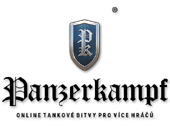
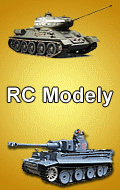
|
|||||||||||||||||||||||||||||||||||||||||||||||||||||||||||||||||||||||||||||||||||||||||||||||||||||||||||
přejímání textů ze stránek Panzernet.net bez písemného souhlasu provozovatele je zakázáno; Ochrana soukromí; Copyright; Zdroje |
|||||||||||||||||||||||||||||||||||||||||||||||||||||||||||||||||||||||||||||||||||||||||||||||||||||||||||||
